Basics
This page is an administration page intended for the editing community only. Click this link to go to the handbook front page intended for public viewing.
Entrada de Notas
MuseScore permite entrada da notação musical a partir de qualquer um dos quatro dispositivos de entrada:: via teclado do computador, mouse, teclado MIDI ou teclado de piano virtual. O modo padrão de entrada de notas ou pausas se dá de forma que cada é inserida uma de cada vez. No entanto, outras possibilidades de entrada estão disponíveis.
Após sair do Assistente de Nova Partitura, sua nova partitura terá uma série de compassos preenchidos com pausas de compasso:

Conforme você insere as notas em um compasso, as pausas são alteradas por pausas apropriadas para preencher o restante do compasso:

Notas com durações diferentes em um mesma batida são inseridas usando vozes:

Entrada básica de notas
Esta seção apresenta conceitos básicos para entrada de notas e pausas passo a passo a partir do teclado de um computador. É ainda recomendado que você siga o tutorial, "Iniciando: Uma introdução à entrada de notas no MuseScore", disponível na ReCriar nova .
Passo 1. Selecione a posição de início
Selecione uma posição inicial para entrada de nota clicando em uma nota ou pausa, ou selecionando um compasso, usando o mouse. Se você não selecionar um ponto de partida, o cursor irá automaticamente para o início da partitura quando você entrar no modo Entrada de Nota ("Passo 2" abaixo).
Passo 2. Entrar no Modo de Entrada de Notas
Para entrar no Modo Entrada de Nota, use uma das seguintes opções:
- Clique no ícone "N" (na extremidade esquerda da barra de ferramentas Entrada de Nota).
- Tecle N no teclado do seu computador.
Para sair do modo Entrada de Nota , use uma das seguintes opções:
- Pressione N.
- Pressione Esc.
- Clique no botão "N" na barra de ferramentas.
Passo 3. Selecione a duração
Ainda no modo de Entrada de Nota, selecione a duração de uma nota usando uma das opções abaixo:
- Clique no ícone correspondente da nota na barra de ferramentas para Entrada de Nota (diretamente acima da janela do documento):

- Digite o atalho de teclado para esta duração (veja abaixo).
Passo 4. Insira a nota ou pausa
- Para inserir uma nota de A–G, pressione a letra correspondente no teclado do computador ou coloque-a usando o mouse/touchpad (e um clique "normal" com o botão esquerdo).
- Para inserir uma pausa, pressione 0 (zero) ou clique com o botão direito do mouse.
Este método também pode ser usado se você não estiver no modo para Entrada de Nota— contanto que tenha selecionado uma nota ou pausa, ou a partitura tenha sido recém criada (neste caso, a entrada da nota será o início por padrão).
Selecione a duração da nota/pausa
Os seguintes atalhos de teclado são usados para selecionar a duração da nota/pausa no modo Entrada de Nota:
- 1/64 (semifusa): 1
- 1/32 (fusa): 2
- 1/16 (semicolcheia): 3
- 1/8 (colcheia): 4
- 1/4 (semínima): 5
- 1/2 (mínima): 6
- 4/4 (semibreve): 7
- 8/4 (breve): 8
- Longa: 9
- Máxima: . (muda a seleção para uma nota/pausa pontuada)
Veja também: Quiálteras.
Durações adicionais
- Pontuação Dupla, tripla e quádrupla: Aplicar a partir da barra de ferramentas de entrada de nota, na área de trabalho avançada ou através de shortcut.
- Nota Quartifusa: Ditto.
- Durações Tremifusa, 512th ou 1024th : Primeiro entre uma nota Quartifusa (ou outra mais longa), em seguida divida ela na quantidade de vezes que precisar, através do atalho Q ou, como ou 3.5, via um atalho padrão, ou, ainda, via as entradas correspondentes na barra de ferramentas de entrada de nota padrão na Área de Trabalho.
Dispositivos de entrada
A notação musical pode ser inserida via:
- Teclado de computador.
- Mouse.
- Teclado MIDI.
- Teclado Piano Virtual.
- Qualquer combinação das opções acima.
Teclado de computador
Esta seção expande "Entrada básica de nota" (veja acima) e apresenta uma relação completa de comandos disponíveis para inserir notas ou pausas a partir do teclado do computador.
Entrada de notas/pausas
Você pode inserir uma nota digitando a letra correspondente no teclado. Depois de entrar no modo Entrada de Nota, digite: 5 C D E F G A B C.

Nota: Quando você insere uma nota usando o teclado, o MuseScore a coloca próxima à nota anteriormente inserida (acima ou abaixo).
Para inserir uma pausa, digite "0" (zero). Após entrar no modo de Entrada de Nota , digite: 5 C D 0 E.

Nota: A duração selecionada na barra de ferramentas se aplica a ambas as notas e pausas.
Se você deseja inserir uma nota pontuada, pressione . (período/ponto final) após selecionar a duração.
Por exemplo, após entrar no modo de Entrada de Nota, digite: 5 . C 4 D E F G A.

Se você desejar inserir uma quiáltera: veja Quiálteras.
Se você deseja escrever uma música com duas ou mais linhas simultâneas com melodias independentes na mesma pauta, consulte Vozes.
Mover notas para cima/baixo
Para subir ou descer a altura de uma nota em um semitom:
- Pressione as setas ↑ ou ↓.
Para subir ou descer a altura de uma nota diatonicamente:
- Pressione Alt+Shift+↑ ou Alt+Shift+↓.
Para subir ou descer a altura de uma nota em uma oitava:
- Pressione Ctrl+↑ (Mac: Cmd+↑) ou Ctrl+↓ (Mac: Cmd+↓).
Adicionar acidentes
Quando uma nota é movida para cima ou para baixo através da tecla de seta (veja acima), um acidente é automaticamente gerado. Acidentes também podem ser adicionados manualmente—veja Acidentes.
Acordes
Se você deseja adicionar uma nota de acorde à sua entrada anterior:
- Pressione e segure Shift, insira uma nota de A até G.
Digitando C, D, Shift+F, Shift+A, E, F o resultado é:

Para acrescentar uma nota a um intervalo específico acima ou abaixo de uma ou várias notas:
- Assegure-se que uma ou mais notas foram selecionadas;
- Use uma das opções:
- No menu, selecione Inserir→Intervalos e escolha um intervalo da lista;
- Pressione Alt+1-9 para intervalos acima (intervalos abaixo também são possíveis a partir de atalhos na lista de Preferências).
Nota: Para criar acordes contendo notas com diferentes durações, é necessário usar mais de uma Voz.
Inserir Notas
Normalmente, quando você insere uma música no MuseScore, as notas ou pausas existentes são substituídas. Existem, no entanto, várias maneiras de inserir notas:
- Inserir compassos extras na partitura.
- Cortar e colar uma seção da partitura e inserir a música no espaço liberado.
- Para inserir uma nota, pressione Ctrl + Shift (Mac: Cmd + Shift) + o nome da nota, de (A até G). Desta forma, será inserida uma nota com a duração selecionada e as demais notas serão movidas para a direita na mesma partitura. Se o compasso exceder a duração da fórmula de compasso, um sinal azul de adição aparecerá acima do compasso como em Mode de Inserção.
Excluir notas
Para excluir uma única nota:
- Selecione a nota e pressione Del (Mac: Barra de Espaço).
Para excluir um acorde:
- Pressione Esc para assegurar que está no Modo Normal.
- Pressione Shift e clique em uma nota para selecionar o acorde.
- Pressione Del (Mac: Barra de Espaço).
A exclusão pode também ser feita em uma faixa de notas/acordes.
Atalhos via teclado do computador
Aqui está uma lista de atalhos para edição, disponíveis no modo Entrada de Notas:
- ↑ (Acima): Sobe a altura de uma nota em um semitom (usa ♯).
- ↓ (Abaixo): Desce a altura de uma note em um semitone (usa ♭).
- Alt+1-9: Adicione um intervalo (uníssono à nona) acima da nota atual.
- J: Muda uma nota para cima ou para baixo para o seu enarmônico equivalente. (e.g. D♯ para E♭). Isso altera a grafia no tom do concerto e nos modos de transposição. Veja Acidentes.
- Alt+Shift+↑: Sobe a altura de uma nota usando a armadura da clave.
- Alt+Shift+↓: Diminue o tom de uma nota usando a armadura de clave.
- R: Repete a última nota inserida
- Q: Divide pela metade a duração da última nota inserida.
- W: Dobra a duração da última nota inserida.
- Shift+Q: Reduz a duração em um ponto (por exemplo, uma semínima pontuada se transforma em uma semínima, e uma semínima em uma colcheia pontuada).
- Shift+W: Aumenta a duração de uma nota em um ponto (por exemplo, uma colcheia se transforma em uma colcheia pontuada, e uma colcheia pontuada em seminima).
- Barra de Espaço: Desfaz a última nota inserida.
- Shift+←: Trocar a última nota com a inserida anteriormente (repita para continuar movendo a nota anterior)
- Shift+→: Trocar nota movida com Shift+← com a nota que segue
- X: Inverter a direção da haste da nota (pode ser redefinido para a posição automática em Inspetor)
- Shift+X: Mover a cabeça da nota para o lado oposto da haste (pode ser redefinido para a posição automática em Inspetor)
- Ctrl+Alt+1-4: Mudar para a correspondente voz)
Mouse
É fácil inserir notas com o mouse, mas não é a maneira mais rápida para inserir muitas notas.
- Clique no símbolo de duração da nota desejada em Barra de ferramentas de Entrada de Nota.
- Clique na partitura para adicionar uma altura com a duração selecionada.
- Para adicionar mais notas a um acorde existente, apenas repita o passo 2.
- Para substituir em um acorde existente (ao invés de adicionar a ele), pressione Shift antes de clicar.
- Para adicionar uma pausa, clique com o botão direito.
Nota: Se você passar o cursor sobre a partitura no modo de Entrada de Nota, será exibida uma prévia da nota ou pausa a ser adicionada.
Teclado MIDI
Você também pode inserir alturas usando um teclado MIDI.
- Conecte o teclado MIDI ao computador e ligue o dispositivo.
- Inicialize o MuseScore (isso deve ser feito ** depois ** que o teclado for ligado)
- Criar uma nova partitura
- Clique na pausa (selecionando-a) do compasso 1 para indicar o ponto onde começará a entrada de notas
- Pressione N para entrar no
modo entrada de nota - Selecione a duração da nota, tal como 5, para semínimas, conforme descrito acima above
- Pressione uma nota no seu teclado MIDI.
A altura deve ser incluída na sua partitura. Se o tom não aparecer, use a barra de ferramentas e clique em 'Alternar entrada MIDI' ou siga este passos:
- No menu, selecione Editar→Preferências... (Mac: MuseScore→Preferências...).
- Clique na aba Entrada de Nota e marque "Habilitar entrada MIDI".
- Clique OK para sair. Reinicie o MuseScore para confirmar a alteração.
Nota: O método de entrada padrão Passo a Passo permite a entrada de uma nota por vez. Para outras formas de entrada de notas acesse Modos para Entrada de Nota.
Se você tiver vários dispositivos MIDI conectados ao seu computador, pode ser necessário informar ao MuseScore qual é o teclado MIDI:
- No meu, selecione Editar→Preferências... (Mac: MuseScore→Preferências...).
- Clique na aba E/S e selecione seu dispositivo na seção "Entrada MIDI".
- Clique OK para sair. Reinicie o MuseScore para confirmar a alteração.
Teclado de Piano Virtual
Você também pode inserir notas usando o teclado de piano na tela.
- Para alternar a exibição entre ligada e desligada : Pressione P (ou selecione Visualizar→Piano).
- Para redimensionar o teclado: Posicione o curso do mouse sobre as teclas do piano, segure Ctrl (Mac: Cmd) e mova a rolagem do mouse para cima (maior) ou para baixo (menor).
O método de entrada de nota é semelhante ao do teclado MIDI:
- Certifique-se que você está no Modo de Entrada de Nota.
- Para incluir:
- Uma única nota: Clique na respectiva tecla do piano.
- Acorde: Selecione a nota que você deseja incluir, pressione e segure Shift, clique em uma teclado do piano (nas versões anteriores a 2.1, use Ctrl (Mac: Cmd). Repita conforme necessário.
Modos de Entrada de Nota
MuseScore oferece uma variedade de modos de entrada de nota além do Passo a Passo. Todos podem ser acessados através de um clique na pequena seta ao lado do botão "N", à esquerda da barra de ferramentas de Entrada de Nota:
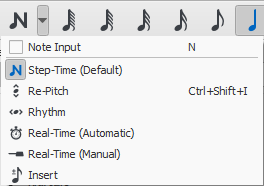
- Passo a Passo (padrão): Modo de entrada de nota padrão. Veja Entrada de nota básica (acima).
- Alteração de Altura: Substitui as alturas sem modificar os ritmos.
- Ritmo: Insere as durações com um único clique ou pressionamento de tecla.
- Tempo real (automático): Executa a peça em um andamento fixo indicado por um beat de metrônomo.
- Tempo real (manual): Executa a peça enquanto se pressiona uma tecla ou pedal para definir o beat.
- Inserir: (Chamado de "Timewise" até a versão 3.0.2) Insere e exclui notas e pausas nos compassos, mudando automaticamente a música subsequente para a frente ou para trás.
Coloração de notas fora da tessitura de um instrumento
Dependendo da habilidade do músico, certas notas são consideradas fora do alcance de um instrumento específico. Para fins informativos, o MuseScore opcionalmente colore notas em vermelho, se estiverem fora da faixa de um "profissional" e, em verde oliva/amarelo escuro, se estiverem fora da faixa de um "amador". As cores aparecem na tela do computador, mas não nas cópias impressas.

Para habilitar/desabilitar a coloração de notas e configurar os parâmetros das tessituras "profissional" e "amador", veja Tessitura utilizável (Propriedades da Pauta: todas as pautas).
Pequenas notas/pequenas cabeças de nota
- Selecione a(s) nota(s) que deseja em tamanho pequeno.
- Marque a caixa de seleção "Pequeno" no Inspetor. A opção
Notaé usada para modificar o tamanho da cabeça de apenas uma nota; aAcordemudará os tamanhos de cabeça de nota, haste, barra de ligação e bandeirola.
Por padrão, o tamanho pequeno é 70% do tamanho normal. Este valor pode ser alterado em Formatar → Estilo…→Tamanhos.
Alterar notas ou pausas já inseridas
Mudar a duração
Versão 3.3.3 e superior
1. Certifique-se que você está no Modo Normal.
2. Selecione um ou mais notas/pausas, ou nota-hastes/pontas. Aplique o atalho de duração desejada (listado acima), ou clique no ícone da duração equivalente, na barra de ferramentas.
Antes da versão 3.3.3
1. Certifique-se que está no Modo Normal.
2. Clique em uma nota ou pausa. Acione o atalho de duração desejada (listado acima), ou clique no ícone de duração equivalente na barra de ferramentas.
Nota: Aumentar a duração substituirá as notas ou pausas seguintes; diminuir a duração adicionará pausas entre estas e as notas ou pausas seguintes.
Por exemplo, para mudar três pausas de semicolcheias para uma pausa de semínima pontuada:
- Clique na primeira pausa de semicolcheia.
- Tecle 4 para transformá-la em uma pausa de colcheia.
- Tecle . para transformá-la em uma pausa de colcheia pontuada.
À medida que a duração aumenta ela substitui as duas pausas de semicolcheias que seguem.
Mudar a altura
Para mudar a altura de uma única nota:
- Certifique-se que você não está no modo de Entrada de Nota e que nenhuma outra nota está selecionada.
- Selecione a nota desejada e use um dos seguintes métodos:
- Arraste a nota para cima ou para baixo com o mouse;
- Pressione as teclas do teclados: ↑ (acima) ou ↓ (abaixo);
- Digite a letra que representa a nova nota (A…G). Use Ctrl+↓ ou Ctrl+↑ para ajustar a oitava, se for necessário (Mac: Cmd+↓ ou Cmd+↑). Assim, o modo de Entrada de Nota será automaticamente ativado.
Para alterar a grafia enarmônica de uma nota, selecione-a e use o comando J. Para mais informações, veja Acidentes.
Para mudar a altura do trecho de uma música durante um intervalo constante, veja em Transposição.
Para mudar a altura do trecho de uma música para uma melodia diferente, mantendo o ritmo intacto, veja Modo Alterar a Altura.
Se a sua partitura contém muitos acidentes com erro, acesse a opção you might try the Renomear Alturas (veja Acidentes: Renomear Alturas).
Mudar a voz
Para mudar uma ou mais notas para uma voz diferente, veja Vozes.
Transformar uma pausa em nota e vice-versa
Para transformar uma pausa para uma nota de mesma duração:
- Certifique-se que você não está no Modo Entrada de Nota (pressione Esc para sair).
- Selecione a pausa.
- Insira a altura desejada inserindo a letra de uma nota A–G.
Para transformar uma nota para uma pausa de mesma duração:
- Certifique-se que você não está no Modo Entrada de Nota (pressione Esc para sair).
- Selecione a nota.
- Pressione 0 (Zero).
Propriedades da nota
- Para ajustar a posição horizontal de uma nota/acorde veja Notas de deslocamento.
- Para editar as propriedades de uma nota em geral (espaçamento, deslocamento, tamanho, cor, direção de cabeça de nota, reprodução, etc.): veja Inspetor e propriedades de objeto.
- Para ajustar o layout de todas as notas de uma partitura: veja Layout e formatação, especialmente as seções sobre estilo de notas, acidentes and quiálteras.
Veja também
- Modos de Entrada de Dados
- Notação de percussão
- Tablatura
- Quiáltera
- Vozes
- Cabeças de nota compartilhadas
- Preferências
Links Externos
- Como adicionar um acorde (MuseScore HowTo)
- Como incluir uma pausa (MuseScore HowTo)
- Como estender uma haste por duas pautas (MuseScore HowTo)
- Como incluir notas de sugestão (MuseScore HowTo)
- Vídeo tutorial: MuseScore em Minutos: Aula 3 - Entrada de nOTA
- Vídeo tutorial: MuseScore em Minutos: Aula 4 - Entrada de Teclado MIDI
- Vídeo tutorial: MuseScore em Minutos: Aula 5 - Outras sugestões para entrada
- Vídeo: Demonstração MIDI em Tempo Semi-Real Parte 1: Modos de inclusão de novas notas
- Vídeo tutorial: Dicas rápidas Musescore: Entrada de Nota
ReCriar nova
Para criar uma nova partitura, abra o Assistente de nova partitura (veja Criar nova partitura, a seguir): também pode ser acessado através do Start Center.
Start Center
Esta é a janela exibida quando o MuseScore é aberto pela primeira vez:
NOT FOUND: Start_center_en.png
Para abrir o Start Center (se ainda não estiver visível), use uma das seguintes opções:
- Pressione F4.
- Na barra de menu, selecione Arquivo→Start Center...
Para que o Start Center deixe de ser exibido quando o MuseScore for aberto:
- Na barra de menu, selecione Editar→Preferências... (Mac: MuseScore→Preferências..) e desmarque a opção "Exibir Start Center" na seção de Início de Início do Programa na aba Geral.
No Start Center você pode:
- Criar uma nova partitura (clicando no ícone com símbolo de adição (+)).
- Visualizar miniaturas das partituras recém abertas: clique na miniatura para abrí-la.
- Abrir uma partitura à partir de um arquivo do computador: clique em Abrir uma partitura...
- Abrir a partitura tutorial "Getting Started" . Use as setas no painel à direta para acessar o link.
- Busque por partituras em musecore.com.
- Acesso a outras funcionalidades (ver painel à direita).
Criar nova partitura
Para abrir o Assistente de Nova Partitura quando o Start Center não estiver aberto, use uma das seguintes opções:
- Cloque no ícone Nova Partitura na barra de ferramentas no canto superior esquerdo da janela;
- Use as teclas de atalho Ctrl+N (Mac: Cmd+N);
- No menu, selecione Arquivo→Novo....
Inserir dados na partitura
NOT FOUND: Create_new_score-Title_en.png
Passo 1: Incluir os dados da partitura.
Digite o título, o compositor e as demais informações, conforme apresentado acima, e clique em Próximo >. Esta etapa é opcional: você pode adicionar esta informação após a criação da partitura (veja Vertical frame).
Escolha um modelo
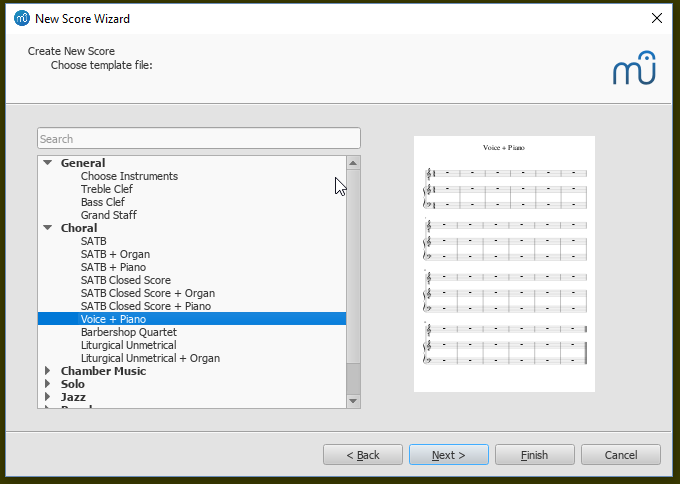
Step 2: Escolha um arquivo modelo.
Na coluna esquerda há uma lista de modelos solo, conjuntos ou orquestrais, classificados em categorias de acordo com estilos musicais. Todos os modelos previamente personalizados e salvos na pasta de modelos do seu computador serão exibidas como "Modelos Personalizados". Você pode ainda buscar específicos modelos a partir da Barra de Busca (acima à esquerda).
Para escolher um modelo de partitura:
-
Clique no nome de um modelo de partitura para selecioná-lo, depois clique em Próximo >; ou, apenas clique duas vezes no nome do modelo da partitura para ir automaticamente para a próxima página do Assistente (veja Selecione tonalidade e andamento).
-
Se você preferir criar um modelo do zero, clique em "Selecione Instrumentos" (em "Geral"), depois clique no botão Próximo >; ou, faça um duplo clique em "Selecione Instrumentos."
Selecione Instrumentos (ou partes vocais)
NOT FOUND: Create_new_score-Add-instruments_en.png
A janela Selecione Instrumentos é dividida em duas colunas:
- A coluna da esquerda possui uma lista com instrumentos ou vozes, sendo classificada pela família dos instrumentos. Clicar em uma categoria irá exibir a lista completa de instrumentos de cada família.
A entrada padrão é "Instrumentos Comuns" mas outras opções podem ser selecionadas, como "Instrumentos de Jazz" e "Música Antiga". Ao digitar o nome de um instrumento no campo pesquisa, localizado no topo da janela do instrumento, você poderá fazer uma busca em "Todos instrumentos".
- A coluna da direita é iniciada vazia, mas depois conterá a lista de instrumentos da nova partitura, na ordem em que aparecerão.
Adicionar instrumentos
Para adicionar instrumentos na partitura siga as seguintes opções:
- Selecione um ou mais instrumentos na coluna da esquerda e clique em Adicionar.
- Clique duas vezes em um instrumento na coluna da esquerda.
Os nomes dos instrumentos, e seus respectivos pentagramas, irão aparecer na lista de instrumentos localizada na coluna da direita. Caso necessário, novos instrumentos ou partes vocais podem ser adicionados. Cada instrumento adicionado por esta via é incluído em um canal individual Mixer.
Uma vez que a faixa de um instrumento é incluída em uma partitura, é possível editar as suas características sonoras através do Área da faixa no Mixer. Será apresentado um painel vertical no meu Mixer para este novo instrumento, na metade inferior do painel, próximo ao controle de volume (master Gain). Haverá um painel para cada instrumento da partitura, identificados por seu nomes no topo. Arraste a barra de rolagem vertical para baixo, caso esses nomes não estiverem visíveis. Depois disso, basta clicar no painel e editar o volume, nome, instrumento, chorus, reverb, etc, e as alterações serão efetuadas imediatamente."
Nota: Se você quiser que pentagramas compartilhem um mesmo instrumento, use Adicionar Pentagrama ou Adicionar pentagrama linkado (veja a seguir).
Adicionar Pentagrama / Adicionar Pentagrama Linkado
Para adicionar um pentagrama a um instrumento existente na partitura:
- Selecione o pentagrama na lista de partituras localizada no lado direito (e.g. veja "Pentagrama 1" na imagem abaixo). Clique Adicionar Pentagrama ou Adicionar Pentagrama Linkado.
- Ajuste o Tipo de pentagrama, se for o caso.
NOT FOUND: Create_new_score_Add_staff_en.png
Resumo de comandos:
| Comando | Pentagrama adicionado | Edit staves independently? | Compartilhe canal do Mixer? | Exemplos |
|---|---|---|---|---|
| __Adicionar Pentagrama | Não linkado | Sim | Sim | Violão pentagrama/tablatura, Piano pentagrama |
| Adicionar Pentagrama Linkado | Linkado | No. Editar um pentagrama atualiza outros | Sim | Violão partitura/tablatura |
Veja também, Mesclar pentagrama tradicional com tablatura.
Alterar ordem de instrumentos
Para alterar a ordem dos instrumentos (ou pentagramas) em uma partitura:
- Clique no nome de um instrumento ou pentagrama na coluna da direita, e use os botões de seta para movê-lo para cima/para baixo.
Excluir um instrumento
Para excluir um instrumento ou linha de pauta (pentagrama):
- Selecione um instrumento ou pentagrama na coluna da direita e clique Excluir.
Selecionar armadura (e andamento)
NOT FOUND: Create_new_score-Key_signature_en.png
Passo 3: Escolha a armadura (e andamento).
- Selecione a armadura desejada e clique em Próximo > para continuar. O andamento também pode ser definido aqui para versão anterior à 3.5.
Selecione fórmula de compasso, andamento, anacruse e número de compassos
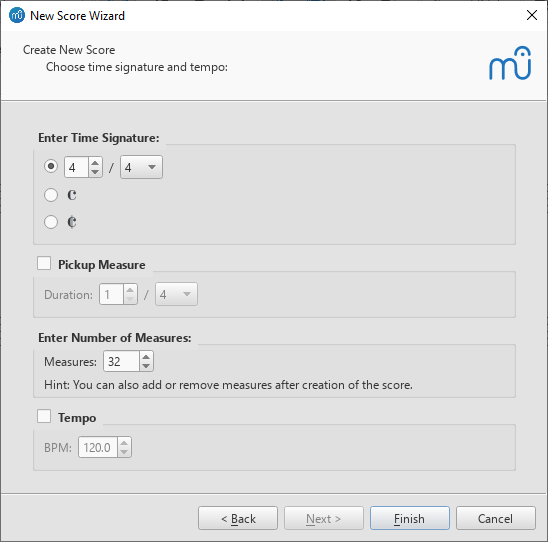
Passo 4: Escolher fórmula de compasso etc.
Aqui é possível::
- Fórmula de compasso inicial.
- pickup measure (Anacruse), e duração.
- Por padrão, o número inicial é de 32 compassos mas é possível incluir/excluir compassos a partir da janela de edição da partitura.
- Andamento (antes da versão 3.5 é definido na página Selecione armadura (e andamento)).
Clique Terminar para criar a nova partitura.
Ajustes em uma recém criada partitura
Qualquer configuração realizada através do Assistente de Nova Partitura pode ser alterada enquanto se estiver editando a nova partitura:
Adicionar / excluir / ajustar compassos
Adicionar/editar texto
- Adicionar texto (Noções básicas sobre Texto).
- Editar texto.
Alterar configurações de instrumento
Para adicionar, excluir ou alterar a ordem dos instrumentos:
- Selecione Editar→Instrumentos... no menu; ou use o atalho I para abrir o painel Instrumentos , que é virtualmente idêntico ao painel Selecione os Instrumentos no Assistente de Nova Partitura (veja acima).
Veja também Mudar instrumento (Propriedades do pentagrama).
Escolher um pentagrama
- Para esconder um pentagrama de forma definitiva: Abra a opção Instrumentos (I) e desmarque e caixa "Visível" para o referido pentagrama.
- Para esconder um pentagrama sob determinadas condições__: Veja a opção "Esconder" em Layout and formatting, and Propriedades do Pentagrama.
Ajustar layout e formatação
Para ajustar a distância entre as pautas e os sistemas, defina as margens da página, etc., veja Layout e formatação.
Modelos
Um Modelo é simplesmente um arquivo MuseScore padrão que foi armazenado em uma das duas pastas de "modelos"(templates): qualquer arquivo localizado nestas pastas é automaticamente exibido em "Selecione arquivo modelo" na página do Assistente de Nova Partitura. Duas pastas de modelo são criadas por padrão:
- Uma [pastas de modelos de sistema(#system-templates-folder).
- Uma pasta de modelos de usuário.
Pasta de modelos de sistema
This folder contains the templates installed with MuseScore and should not be modified. It can be found in the following locations:
Windows: Usualmente em C:\Program Files\MuseScore 3\templates or C:\Program Files (x86)\MuseScore 3\templates (Actually %ProgramFiles%\MuseScore 3\templates or %ProgramFiles(x86)%\MuseScore 3\templates, respectively) .
Linux: Em /usr/share/mscore-xxx se você instalou a partir do gerenciador de pacotes. Se você compilou o MuseScore no Linux, procure em /usr/local/share/mscore-xxx (onde xxx é a versão que está sendo usada).
MacOS: Em /Applications/MuseScore 3.app/Contents/Resources/templates.
Pasta de modelos do usuário
Qualquer modelo que você crie pode ser salvo para uso posterior. Uma vez salvo na pasta "templates"(modelos), eles serão automaticamente exibidos em "Selecione o modelo" na página do Assistente de Nova Partitura—sob o título "Modelos personalizados modelos".
A localização padrão da pasta de modelos do usuário é:
Windows: %HOMEPATH%\Documents\MuseScore3\Templates.
MacOS e Linux: ~/Documents/MuseScore3/Templates.
Para configurar a localização da sua pasta de modelos pessoais:
- Selecione no menu Editar→Preferências...→Geral.
Veja também
Links externos
| Anexo | Tamanho |
|---|---|
| Create_new_score-Title_en_1.png | 17.41 KB |
| Create_new_score-Select_template_en.png | 44.82 KB |
| Create_new_score-Key_signature_en_2.png | 24.84 KB |
| Create_new_score-Time_signature_en.png | 28.72 KB |
| Start_center_en_1.png | 71.27 KB |
| 59fbab11df15aba3ff5c34b0c63bb1e0.jpg | 177.31 KB |
| 59fbab11df15aba3ff5c34b0c63bb1e0.jpg | 177.31 KB |
Modo de Edição
Modo de Edição permite que seja realizada uma série de operações de edição em elementos individuais de uma partitura, tais como:
- Ajustar o comprimento e a forma de ligaduras, linhas, barras de compasso, etc.
- Incluir, excluir e format textos em objetos de texto.
- Ajustar a posição dos elementos de uma partitura (exceto textos).
Entrar no Modo de Edição
MuseScore versões 3.4 e superiores
Para linhas, crescendo/decrescendo, ligaduras, hastes de notas, barras de ligação e , note-beams e barras de compasso, use um dos seguintes métodos:
- Clique em um elemento.
- Clique com o botão da direita em um elemento e, no menu, selecione Editar Elementos.
Para os demais For other elementos, use um dos seguintes métodos:
- Clique duas vezes no elemento.
- Clique em um objeto já selecionado (apenas objetos de texto).
- Clique com o botão da direita em um elemento e, no menu, selecione Editar Elemento.
- Clique em um elemento e pressione Alt+Shift+E.
Versões do MuseScore anteriores à 3.4
Use um dos seguintes métodos:
- Clique duas vezes em um elemento.
- Clique com o botão da direita em um elemento e, no menu, selecione Editar Elemento.
- Clique no elemento e pressione Alt+Shift+E.
Sair do Modo de Edição
Para sair do Modo de Edição faça uma das opções:
- Pressione Esc.
- Clique em uma área em branco da janela do documento.
Texto
Para modo de edição de texto, veja Edição de texto.
Linhas
Veja Linhas: Mude o comprimento, e Ajuste o Legato.
Notas
Notas de deslocamento
Algumas vezes é necessário mover uma nota para a direita ou esquerda- para evitar colisão com outro elemento ou sobreposição automática Noteheads, por exemplo:
- Enter Edit mode on the desired note;
- Press the arrow key in the direction (left or right) that you wish to nudge the note (or use Ctrl+← or Ctrl+→ for larger adjustments);
- Press the Esc key. This will allow the note stem to be redrawn.
Alternatively, you can select the notehead and change the "Horizontal offset" (under "Chord") in the Inspector.
Adjust note stem length
- Enter Edit mode on the desired note stem;
- Use keyboard shortcuts (below) to extend or shorten the stem;
- Exit edit mode.
Alternatively, you can select the stem and change the "Length Offset" (under "Stem") in the Inspector.
To reposition a note stem, you should select it and adjust the "X" or "Y" setting for the "Offset" under "Automatic placement" in the "Element" section of the Inspector.
Keyboard shortcuts
In Edit mode the following keyboard commands can be used to change the position of either (1) a score element (e.g. ornament, accidental etc.) or (2) an adjustment handle (e.g. slur, line etc.):
- ←: Move left 0.1 staff space.
- →: Move right 0.1 staff space
- ↑: Move up 0.1 staff space
- ↓: Move down 0.1 staff space
- Ctrl+← (Mac: Cmd+←): Move left one staff space
- Ctrl+→ (Mac: Cmd+→): Move right one staff space
- Ctrl+↑ (Mac: Cmd+↑): Move up one staff space
- Ctrl+↓ (Mac: Cmd+↓): Moves down one staff space
- Alt+←: Move left 0.01 staff space
- Alt+→: Move right 0.01 staff space
- Alt+↑: Move up 0.01 staff space
- Alt+↓: Move down 0.01 staff space
The following commands only apply to adjustment handles:
- Shift+←: Move end handle's anchor left by one note/rest.
- Shift+→: Move end handle's anchor right by one note/rest.
- Tab: Go to next handle.
To undo all edits, ensure you are not in edit mode and press Ctrl+R.
See also
Palettes
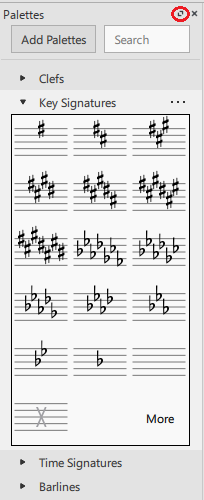
Overview
Using the Palettes Area is the recommended way to apply musical symbols and text to your score, second to keyboard shortcut.
MuseScore is shipped with predefined palettes that organize items by nature, click on hyperlink to jump to their main chapter.
- Visible by default in the built-in MuseScore 3.6.2 Basic workspace profile: Clefs, Key Signatures, Time Signatures, Accidentals, Articulations , Grace Notes, Lines , Barlines, Text, Tempo, Dynamics, Repeats & Jumps, Breaks & Spacers, Beam Properties.
- Visible by default in the built-in MuseScore 3.6.2 Advanced workspace profile, in addition to all of the above palettes: Brackets, Ornaments, Breaths & Pauses, Noteheads, Arpeggios & glissandi, Tremolos, Fingering, Fretboard Diagrams, Frames & Measures.
- Not yet visible in any build-in workspace profile by default: Accordion (see How-to: Accordion notation and playback), Bagpipe Embellishments.
All palettes can be unhide in any workspace (see below (jump to).) The current visibility setting and expand/collapse status palettes are automatically saved to the current in-use workspace profile. No further action is needed.
Palette contents can be edited, you can also create an empty custom palette and populate it, see below (jump to). Visit https://musescore.org/en/node/355834 for palettes shared by other musicians.
Alternative ways to apply musical symbols and text:
- Use Keyboard shortcuts, see also Note input
- Use Toolbar buttons
- Use the Master palette, or
- Use Images.
View / hide the Palette Area
The default position of the Palette Area is to the left of the document window. To view or hide it:
- From the menu, select View → Palettes, or use the keyboard shortcut F9.
To undock the Palette area:
- Click the double-chevron symbol (circled in the image above), or double-click the top bar of the panel.
To re-attach the panel, double-click on the top bar again. See Side panels for more information.
Using palette items
Apply symbols from a palette
Versions 3.4 or above
- Select one or more score elements, then click the desired palette symbol. Or, drag and drop the symbol onto the desired score element in the staff.
Versions prior to 3.4
- Select one or more score elements, then double-click the desired palette symbol. Or, drag and drop the symbol onto the desired score element in the staff.
If you are dragging a symbol to the score and decide you don't want to apply it, press Esc.
Tip: To prevent accidental rearrangement of contents during use, right-click a palette name and uncheck Enable Editing.
Apply the last selected item
MuseScore does not offer keyboard shortcut bindings to palette items, but you can configure a shortcut to apply the same symbol multiple times consecutively to improve efficiency. Some users find this method handy when applying piano pedal marks. (N.B. piano pedal mark symbol is under Lines palette)
- Assign a keyboard shortcut key to "Apply current palette element" in Preferences: Shortcuts.
- Select some score elements.
- Click on a palette item to apply it to the score once.
- Select other elements. TIPS: Use Shift selection Shift+←/→.
- Press the "Apply current palette element" shortcut to apply the same (last applied) item.
- Repeat as required.
See also Dynamics actions, a MuseScore plugin that you can assign keyboard shortcut to add individual dynamics symbol.
Search for symbols
Search by symbol name to locate a symbol without visually searching through palettes. All symbols are searched regardless of palettes' visible / hidden status and expand / collapse status.
Use the Search box at the top of the Palette Area. As you type, symbols and/or palettes with names matching your keystrokes are displayed below, updating continuously as your typed input changes.
To show all palettes, some of which may be temporarily hidden because it does not match the search string, click X in the search box.
Items added to the score can be copied, pasted, and duplicated: see Copy and paste.
Behavior of applied text and lines
If the symbol you are adding to the score from a palette contains or belongs to a Text element (e.g. staff text, dynamic, fingering, volta etc.), then properties such as font type, font size, text color and alignment will adapt according to the following rules:
- Text properties which have not been altered by the user will adopt the relevant text styles.
- Custom text properties—those changed by the user before saving the symbol to a custom palette—remain as customized.
By contrast, the line properties of Lines applied from a palette as is.
Customize the Palette Area
Expand / Collapse a palette
- Either click on the arrow next to the palette name, or double-click the palette name (in versions prior to MuseScore 3.3, click once on either the arrow or the palette name).
Single Palette mode
- To enable automatic collapsing of all other palettes when you expand one palette, click the ... button at the top of the Palettes Area and check the Open only one Palette at a time box.
Reveal a hidden palette
- Click Add Palettes at the top of the palette list and click Add beside the palette name.
Create a new custom palette
- At the top of the Palette Area, click Add Palettes→Create custom palette. Or, right-click any palette and click Insert New Palette.
- Type the name of the new palette in the Create Palette dialog.
- To add symbols, see Customize palettes below (jump to).
Hide a palette
To hide a predefined palette:
- Right-click the name of the palette you want to hide and click Hide Palette.
To hide a custom palette you created:
- Right-click the name of the palette you want to hide, click Hide/Delete Palette, then click Hide in the dialog.
Delete a palette
Only custom palettes can be deleted, you can hide all palettes though.
- Right-click the name of the palette you want to delete, click Hide/Delete Palette, then click Delete permanently in the dialog.
Change the order of palettes
- Drag the name of a palette up or down to any desired position.
Customize palette contents
Symbols may be added or deleted and layouts can be rearranged. (in version prior to 3.3, only new workspace is capable of customizations).
Before customizing a palette:
- Right-click on the palette name and make sure that Enable Editing is checked. It is automatically checked for new palettes you create yourself.
- Make sure the palette is expanded.
Add from an opened score
Score items, when added to a palette, are saved with their custom properties.
- Press and hold Ctrl+Shift (Mac: Cmd+Shift), then drag the score element from the score onto a palette. The score element could be a symbol, line, text, dynamic, fretboard diagram, imported image etc.
Add from the Master Palette
- If the Master Palette is not visible, select View → Master Palette from the menu, or use the keyboard shortcut Shift+F9 (Mac: fn+Shift+F9).
- Drag the symbol from the Master Palette window onto a palette.
Rearrange symbol order
- Drag the symbol to the cell in which you wish to display it. Nearby symbols will automatically move to make space available.
Change the position and size of a symbol in a palette cell
- Right-click the cell and click Properties. The following dialog is displayed:
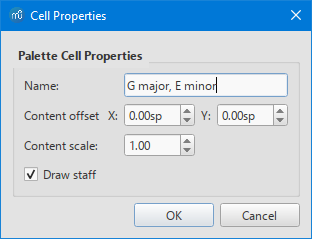
- Name: Used in search function, also shown as tooltip that appears when you mouse over the cell.
- Content offset X, Y: Adjusts the position of the symbol in the cell.
- Content scale: Makes the symbol appear larger or smaller in the cell.
- Draw staff: Draws the five lines of a musical staff behind the symbol.
Note: Changing these values only affects the appearance of symbols within the palette. It does not change their sizes or offsets on the score page.
Remove a symbol from a palette
- Right-click the symbol and click Delete. Or, select the symbol and click the trash icon to the right of the palette name.
Items removed from predefined palettes are moved under More.
In custom palettes, the More button offers browsing predefined palettes ( Use < and > ) and adding their items ( Use drag-and-drop, or selecting and clicking Add to)
Palette menu
The following menu options may appear either by right-clicking the name of a palette or by clicking the ... to the right of the name:
- Hide Palette: Hide predefined palette into under Add Palettes.
- Hide/Delete Palette: Allows you to either hide or permanently delete a custom palette.
- Insert New Palette: Creates a new empty palette. Identical to Add Palettes→Create custom palette.
- Enable Editing: Allows you to modify the contents and layout of the palette.
- Reset Palette: Discards any customizations made to a palette and restore its default contents and layout. Custom palettes will be emptied.
- Save Palette...: Saves the current palette as an .mpal file.
- Load Palette...: Loads a palette from an .mpal file and reveal it, does not replace current palette, nor any existing palettes.
- Palette Properties...: Displays the following dialog, where you can adjust the appearance of a palette:
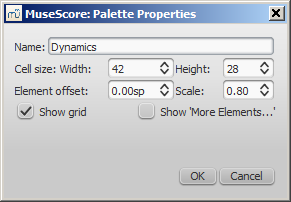
- Name: The name of the current palette.
- Cell Size: Width, Height: The dimensions of each individual cell in the palette.
- Element Offset: Adjusts the vertical offset of all symbols in the palette.
- Scale: Makes all symbols in the palette appear larger or smaller.
- Show grid: Draws a border around each palette cell.
See also
External
- https://musescore.org/en/node/355834 custom palettes shared by other musicians.
Workspaces
Workspace is the visual settings, also known as graphical user interface (GUI), of the Musescore program itself. An analogy to the position of the pen, ruler etc on a composer's desk. It includes:
- the toolbars and buttons at the top of the window,
- the side panels, or sidebars, to the left of the window, such as Palette, Inspector, Timeline etc,
- their configuration settings and position information, and
- theme and canvas settings, see Preferences.
Note that the followings do not count as workspace:
- View→ Documents Side by Side, Documents Stacked, Full screen, covered in Viewing and navigation chapter.
- View→ Show visible, Show Invisible, Show Unprintable, Show Frames, Show Page Margins, Mark irregular measures, and toolbar's Concert pitch, Zoom level and Page View/Continuous View/Single Page options : these settings are covered in Viewing and navigation chapter. They are score data. They are saved to and loaded from each score file. Templates contain these settings and will be used when you create a new score from a template, see Instruments, staff setup and templates.
Workspace presets are setting profiles for workspace, user can choose the options a preset contains so that only those options are loaded and saved when the preset is applied. There are two default presets: Basic and Advanced, you can create your own custom workspaces.
Apply a preset
Use either one of the following methods:
- Select a new preset from the drop-down menu to the right of the Note Input Toolbar (in versions prior to 3.3. this is located at the bottom of the workspace panel), or
- From the menu, select View→Workspaces, and click on one of the options.
Create a new preset
To create a new preset:
- Select an existing preset, see Apply a preset,
- Either
- Click the + button next to the dropdown list, or
- Click View→Workspace→New,
- The following dialog is shown:
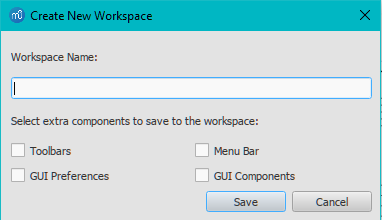
- Enter a name for the new preset,
- Choose what the preset saves and loads, namely:
- Toolbars: Information about toolbars and toolbar buttons and their order.
- Menu bar: No function, as this is not implemented in MuseScore 3.
- GUI Components: Information about the position of the GUI components and whether they are open or not.
- GUI Preferences: Settings in Preferences such as Theme and Canvas settings.
- Press Save
Edit what settings a preset contains
To change what settings a preset contains, select View→Workspace→Edit. In versions prior to MuseScore 3.3, you must create a new preset and then edit it, you cannot edit the Basic preset or the Advanced preset, see Create new workspace preset.
Changes made to the current workspace are automatically saved to the current preset, no further action is required, see Edit the workspace below.
Edit the workspace
Any changes you make to the current workspace are automatically saved to the current preset, no further action is required.
See the main chapter Viewing and navigation, these are some popular ways:
- To choose which toolbar is displayed, toggle them under View→Toolbars menu.
- To edit toolbar buttons, select View→Toolbars→Customize toolbars, see Viewing and navigation : Toolbars. You cannot add items to a toolbar from the Master palette.
- To choose which sidebar is displayed, toggle them under View menu.
- To dock or undock sidebars, see Viewing and navigation : Side panels.
- To setup different sidebars, refer to their relevant chapters. For example, to set up palette see Palettes and Master palette.
Preset directory
Each preset is saved as a separate file under:
- Windows:
C:\Users\[USERNAME]\AppData\Local\MuseScore\MuseScore3\(actually%LOCALAPPDATA%\MuseScore\MuseScore3) - MacOS:
~/Library/Application\ Support/MuseScore/MuseScore3/. - Linux:
${XDG_DATA_HOME:-~/.local/share}/MuseScore/MuseScore3/.
See also
- Viewing and navigation for setting up toolbar and buttons.
- Palettes
- Master palette
Inspector
Overview
The Inspector shows layout and playback properties of the selected objects.
When the current selection of objects consist of several different object types, the Inspector shows and allows adjustment of color, visibility, and automatic placement, see "Element" section. Press any of Notes, Grace Notes, Rests buttons at the bottom to to narrow to that object type only, as shown in image below. See also "Select all similar" and "Selection Filter" sections in the Selection modes chapter.
When multiple objects are selected, if a single property has diverse values for each object, that particular property is displayed in the color blue.
Displaying the Inspector
The Inspector appears by default on the right. To show or hide it:
- Press shortcut F8 (Mac: fn+F8), or
- From the menu, select View and check or uncheck Inspector.
Docking/undocking the Inspector

Click the double-chevron symbol or double-click the top bar of the panel. To re-attach the panel double-click on the top bar again. See also: Side panels.
"Reset to style default" and "Set to style" buttons
Two buttons may be displayed to the right of a property:
- Reset to style default: removes the specific property, in effect resets the property to the default value.
- Save as style : Does these:
- Assigns the property value to the coresponding one in the style profile used by this object currently, found under Format→Style. See Layout and formatting chapter.
- And then clears the property value specific to this object.
- The result is that this object does not have the specific property anymore, but it uses the value in the style profile, which is the same value, because it is being assigned just now. All objects using that style profile across the score is affected.
Shown below is the Reset to style default button, it looks like an unclosed circular loop with a letter x inside

Shown below is the Set as style button, it looks like a bold capitalized S

Inspector categories
Properties are conveniently listed under bold categories in the Inspector. For example, when barline(s) are selected, the following is displayed at the top:
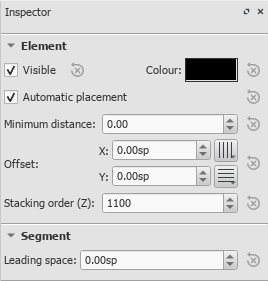
For details of the various categories and their properties, see below:
Element
All score elements—except frames, breaks and spacers—display this category in the Inspector when selected. The options are as follows:
- Visible: Uncheck this box to make selected elements invisible; alternatively, use the shortcut V (toggle). Invisible elements do not appear in the music when printed out or exported as a PDF or image. If you still want them to remain on display in the document window, make sure that the "Show Invisible" option is selected in View → Show Invisible. Invisible elements will then be colored light gray.
- Color: Click on the rectangle to open a "Color Select" dialog. Adjust the color and opacity of selected elements.
- Automatic placement: See Automatic placement.
- Minimum distance: Minimum distance from other elements when automatic placement is enabled.
- Offset X/Y: Allows you to position selected elements exactly (in terms of space units). A positive number moves the elements right or down; a negative number moves the elements left or up. Snap to grid buttons are also provided.
- Stacking order (Z): See Automatic placement: Stacking order
Element Group
This category is displayed only when you have selected a mixture of different types of elements, and allows editing of color, visibility, and automatic placement only.
Segment
- Leading Space: Use this to increase or decrease the space before an element. This also affects any associated lyric syllables.
Chord
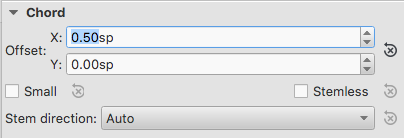
- Offset X/Y: This changes the positon of every note in the same voice as the selected note(s). If you want to make changes to the position of just one note, use the Element category instead).
- Small: Make noteheads and stem small.
- Stemless: Make chord stemless.
- Stem direction: Choice of Auto, Up, or Down.
Note
This category allows you to make changes to selected notes (but for note position—see Element). It contains the following properties:
- Small: Make notehead smaller (you can specify the relative size of all small notes from the menu: Format → Style… → Sizes…).
- Head group: See Notehead groups.
- Head type: See Notehead types.
- Mirror head: Position notehead to the left or right of the stem (default is "Auto").
- Fix to line: When ticked, the note is fixed to the top line of the standard 5-line staff.
- Line: A positive number moves the "fixed" note down; a negative number moves it upwards.
- Play: Unticking this box silences the note.
- Tuning: Adjust tuning of note to the nearest cent.
- Velocity type: Sets the MIDI velocity of notes directly. Choose one of two options:
- Offset: Make the value shown in "Velocity" relative to the previous dynamic marking. The value is taken as a percent offset, i.e. the note’s real MIDI velocity would be ((100 + Velocity) / 100) times what it would have been without this adjustment. Enter negative values to lower the velocity accordingly.
- User: Make the value shown in "Velocity" absolute (i.e. the MIDI velocity is unaffected by dynamic markings).
- Velocity: Set the MIDI velocity according to the option displayed in "Velocity type."
Dynamic
See Dynamics
Text
See Text basics
Tempo text
See Tempo
Fermata
Select
This category appears differently according to the selection you have made:
- If you select a notehead, the "Select" category displays buttons which allow you to easily switch the selection to the stem, beam, hook, duration dot (or dots) or tuplet number associated with the notehead (see image below).

- If you select a range of measures, the "Select" category allows you to select either all notes, grace notes, or rests.
Beam
This section is displayed in the Inspector when you select one or more note beams, and allows you to make fine adjustments to beam position and angle, and also change the spacing of beamed notes.
Clef
This section appears when you select a clef: the tick box allows you to turn on/off the display of a preceding courtesy clef.

Articulation
This category appears when you select an articulation or ornament. The following options are available:
- Direction: Whether the symbol points up or down: only applicable to certain symbols.
- Anchor: The vertical placement of the symbol:
- Play: Turn on/off playback effect.
- Time stretch: Obsolete. Jump to Fermata instead.
- Ornament style: A choice of default or Baroque playback.
Fretboard diagram
See Fretboard diagrams.
Line
This category is displayed when a line is selected. Here, you can set various general properties.
- Visible: Hide or display just the line: any text remains visible.
- Allow diagonal: The default is horizontal (unticked). Tick if you want to edit the line to create a slope.
- Line color/thickness/style: Set various properties of the line.
Text Line Details
This category is displayed when a line is selected. It allows you to set the wording of a line, edit text properties, set line hooks, and align the text in relation to the line.
- Begin hook / Height: At the beginning of the line, specify None, 90° (vertical), 45° (angled), or 90° centered; set hook length.
- End hook / Height: Ditto for the very end of the line.
- Begin Text / Continue Text / End Text: Refers to text at the very beginning of the line; at the beginning of any continuation line; or at the end of the very last line. All have the same properties, as follows:
- Text: Create or edit the text associated with the line.
- Font face / Size / Style: Set the text properties, and/or edit the text style of the line.
- Align: Set the horizontal and vertical alignment of the text in relation to the line.
- Placement: Place the text on (Above/Below), or to the left of the line.
- Offset X / Y: Adjust the x and y offsets for exact positioning.
Properties dialogs
Some object types have additional properties. These are accessed by right-clicking on the object and choosing a "... properties" option from the context menu. The settings available in these dialogs are explained in the description of the object type in Notation or Advanced topics.
See:
- Articulations and ornaments
- Time signatures
- Staff and system text
- Measure operations
- Staff/Part properties
See also
Instruments, staff setup and templates
This chapter discuss real world instruments and vocals, Musescore Instruments, score instrument setup and score template files.
Instruments
An instrument in Musescore is an abstraction that contains,
- Tablature(s) or staff(s). See also Layout and formatting;
- Settings related to playback audio created by the Musescore synthesizer. When setting up sound, start with changing instrument setup;
- Notation styles such as clefs, noteheads; and
- Other musical behaviors such as transposition, playable range.
A Musescore instrument contains staff(s) that can represent a single or multiple real world instrument(s), for example in Beethoven's Symphony No.3, Op.55 First edition published by Cianchettini & Sperati, n.d.[1809] London, the third staff Corni 1 & 2 in Eb represents two French horn players:
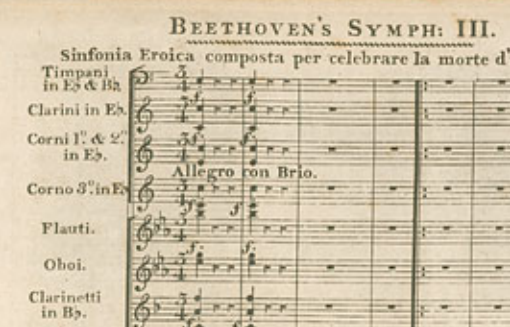
To transcribe this, add one Musescore instrument "Horn in Eb". Optionally rename it. Playback is not affected by naming.

The detailed relationship between Musescore Instrument and real world instrument (staff or tablature), instrument section, vocals, and choir:
- A Musescore Instrument using the same name, such as "Piano", "Acoustic Guitar", "Acoustic Guitar (Tablature)", "Violin", "Violins", "Strings", "Soprano", "Voice", "Women" and some percussions such as "Timpani", "Concert Bass Drum", "Cymbal" (concert). Similar items might have different playback.
- "Drumset" Musescore instrument "Standard" (the option "Drumset"), a single item containing "Snare", "Bass Drum", "Ride Cymbal" etc. There are no seperate MuseScore Instrument for these.
- "Drumset" Musescore instrument "Standard 1" and other variations, (same for "Room", "Power", "Jazz" and theirs), use them by changing Mixer: Sound dropbox. They are different in playback only.
- "Drumset" Musescore instrument "Brush" and variations, use them by changing Mixer: Sound dropbox. The brush snare is the "Electric Snare" item in Drum notation, only creates short brush playback. There is no seperate MuseScore Instrument for brush snare.
Instruments supported by Musescore 3.6.2 (archived https://musescore.org/en/instruments page December 2022). To suggest adding a missing instrument, see https://musescore.org/en/contribute
Choose instruments
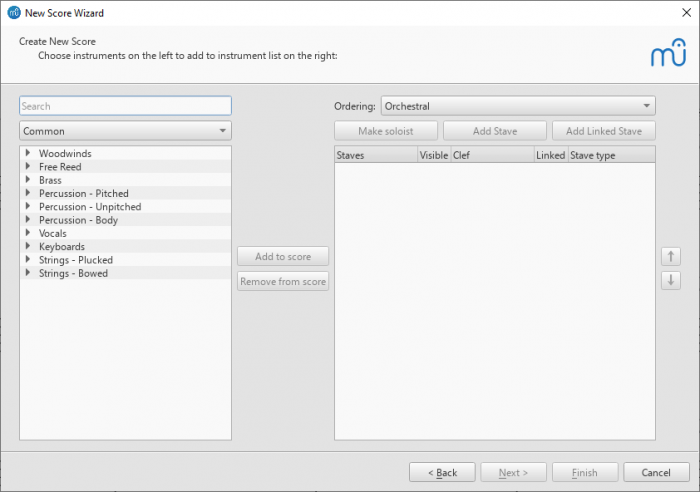
Two ways to open this window to manage setup:
- File New Score Wizard window: Choose Instruments when user create a new score, or
- In a score, use the keyboard shortcut I; or select from the menu Edit→Instruments....
This window contains the following items:
- The search box at the top left filters items to be shown underneath. Clear it out to show all available instruments.
- The type filtering dropdown box under the search box filters items to be shown in the space underneath. "Common" is selected by default, which filters out some uncommon instruments or voice parts. Select "All instruments" to show all available instruments.
- The left column space shows a list of instruments or voice parts that can be added. They are grouped by the instrument families they belong to. Click on a family name subheading to expand or collapse that group.
- The Ordering dropdown box at the top right shows the current automatic vertical arrangement (ordering) of staffs. 'Orchestral' is the default preset. User can always rearrange staffs manually. User cannot edit or create new presets inside Musescore. To utilize templates for custom default ordering on new scores, see template section.
- The right column space shows currect score setup, the vertical order represents the real instrument vertical order on score. Empty column means the score contains no staffs.
The result of actions available in this window are explained in the list below, the steps to do each are shown under corresponding section headings later.
- Add a new instrument to the score: The essential and most common action. Adds a new instrument and staff(s).
- Add a staff to an existing instrument: Inserts an extra editable staff to an existing instrument (on the right column space) and create a custom instrument. For example, to create a piano that use three staffs rather than normally two staffs. Rarely used because its limitation on playback - staffs under the same instrument cannot be configured to use different sounds, nor can they be muted individually. It is advisable to utilize multiple instruments.
- Add a linked staff to an existing instrument: Inserts an non-editable, ready-only staff to an existing instrument (on the right column space). A linked staff automatically mirrors content. Use case includes displaying two staffs for a guitar (a standard staff + a linked tablature) where user enters notes onto the standard staff and the same music is automatically reflected the tablature.
- Make an existing instrument soloist:
-
- Reorders an existing instrument on the score (all its staffs) to the soloist position. The soloist position is defined in the instrument ordering setting chosen in Ordering dropdown box. For example, in an 'Orchestral' ordering preset, soloists are above the strings.
-
- Adds "solo" and a number to its name. Non-soloists do not affect the numbering.
- The soloist designation is a score layout feature only and has no impact on playback. A score can contain multiple "soloist" instruments.
-
Add instrument
To manage instruments of "Drumset" Musescore instrument, see Drum notation
To add a new Musescore instrument to the score, use any of the following options:
- Select one or more instruments in the left column, and then click Add to score in the middle of the window, or
- Double-click an instrument in the left column.
The instrument names, and their associated staff lines, now appear in the list of instruments in the right column.
Add Staff
To add an editable staff to an existing instrument in the score:
- Select a staff of the instrument in the score list on the right-hand side
- Click Add Staff at the top.
- Adjust the Staff type, if applicable.
Add Linked Staff
To add a non-editable ready-only staff to an existing instrument in the score:
- Select a staff to be linked in the score list on the right-hand side.
- Click Add Linked Staff at the top.
- Adjust the Staff type, if applicable.
See also, Combine pitched staff with tablature.
Make / undo soloist
To make an existing instrument soloist, or to undo it:
- Select an instrument name subheading in the score list on the right-hand side.
- Click Make soloist or Undo soloist at the top.
Change order of instruments or staffs on a score
- Click either an instrument name or a staff in the right-hand column, and click the arrow buttons.
Delete an instrument or staff
- Select an instrument (all of its staffs) or a staff in the right-hand column and click Remove from score in the middle.
Change instrument and staff setup
- To change instrument setup of a score: In a score, use the keyboard shortcut I; or select from the menu Edit→Instruments... to open the Instruments window.
- To change instrument setup of a Musescore Part: See Parts.
- To change instrument setup of a the "drumset" Musescore Instrument: See Drum notation: edit drumset.
- To change the Musescore Instrument used by staff on score: See Staff / Part properties: Change instrument.
- To change staff size: It is recommended to use Page settings to change all staffs everywhere on a score , before changing each staff's Staff / Part properties.
- To change staff layout:
- To change staff type and staff layout everywhere on a score (change number of lines, hide etc): See Staff / Part properties, and Tablature
- To hide a staff under certain conditions : See Style window: Score settings.
- To create ossia: See Staff / Part properties: external links
- See also other global style settings in Layout and formatting.
Hiding and unhiding staffs
Edit Format→Style→Score (Style window: Score settings) and Staff / Part properties. Handbook 4 Showing staves only where needed chapter summaries different methods with use cases, the workflow in musescore 3 is similar.
Templates
Not to be confused with Staff / Part properties : staff type template
Score template can be used to quickly set up a new score with staffs and tablatures. A template file is a score file under certain directory that Musescore uses. You can create a score file from scratch and save it to that directory. You can also copy any existing .mscz file to that directory to use it as template.
Generally speaking, global settings are re-used when the new score is created, specific formatting settings on individual objects are not re-used.
There are two kinds of templates:
- Pre-defined System templates shipped with MuseScore,
When you create a new score, they are sorted into categories in Choose template file window . - Custom templates created by user,
The score files must be stored inside the custom templates folder. When you create a new score, they are under Choose template file window : Custom Templates .
As of Musescore 3.6.2, a template contains the following information,
- instrument setup (staffs and tablatures),
- these items of the 'Full score' only,
- Staff / Part properties of all instruments;
- settings under Format→Style and Format → Page Settings. See Layout and formatting chapter;
- the View→ Show visible, Show Invisible, Show Unprintable, Show Frames, Show Page Margins, Mark irregular measures, and toolbar's Concert pitch, Zoom level and Page View/Continuous View/Single Page options. See also Viewing and navigation chapter; and
- the setup (only) of every Musescore Part.
Check out the Score from Template plugin by parkingb which improves template function.
Save a score as a custom template
Click File > Save as and save the score file as .mscz format into the template directory Musescore uses. File name is used as the template name.
Creating a score from a custom template
- Make sure the custom template file is in the correct folder.
- Choose a custom template when you create a new score. In Musescore 3, the preview window shows what the template file looks like when opened as a score, it is not the preview of what a new score looks like when created from this template.
System templates folder
Not recommended to use this folder for custom templates
This folder contains the pre-defined templates. It can be found in the following directory:
- Windows: Usually at
C:\Program Files\MuseScore 3\templatesorC:\Program Files (x86)\MuseScore 3\templates(Actually%ProgramFiles%\MuseScore 3\templatesor%ProgramFiles(x86)%\MuseScore 3\templates, respectively) . - Linux: Under
/usr/share/mscore-xxxif you installed from the package manager. If you compiled MuseScore on Linux yourself, then look under/usr/local/share/mscore-xxx(withxxxbeing the version you are using). - MacOS: Under
/Applications/MuseScore 3.app/Contents/Resources/templates.
Custom templates folder
Custom template files must be stored here. The default directory of the custom templates folder is as follows (The folder name "Templates" varies with the language version of Musescore installed):
- Windows:
%HOMEPATH%\Documents\MuseScore3\Templates. - MacOS and Linux:
~/Documents/MuseScore3/Templates.
To configure the directory of custom templates folder: From the menu, select Edit→Preferences...→General.
External links
- Instruments supported by Musescore 3.6.2 (archived https://musescore.org/en/instruments page December 2022)
- Instruments supported by latest Musescore
Measure operations
This chapter covers adding, removing, splitting and joining measures etc, in addition to the Measure properties dialog which is used to adjust individual measure—such as visibility, duration, numbering and width ("Stretch"). The Measure chapter outline related formattings.
Adding and removing measures in effect insert or remove segment of time, affecting all instruments and staffs. Score items associated with that segment are removed along with it, while rest symbols are added automatically whereever necessary. To ensure that inserted or appended measures display correctly, multimeasure rests should be set to off (toggle M).
Select
Single measure
- To select a single measure, click on a space within the measure.
Range of measures
- To select a continuous range of measures, see Shift + click selection and Shift selection.
Insert
Insert an empty measure into the score
- Select a measure or a frame, then press Ins (Mac: Shift+I); or
- Select a measure or a frame, then choose from the menu: Add→Measures→Insert Measure.
Insert multiple measures
- Select a measure or a frame, then press Ctrl+Ins (Mac: Shift+Del+I); fill in the "Number of measures to insert" field and press OK; or
- Select a measure or a frame, then choose from the menu: Add→Measures→Insert Measures...; fill in the "Number of measures to insert" field and press OK.
Append
Append an empty measure to the end of a score
Use one of the following options:
- Press Ctrl+B (Mac: Cmd+B).
- Select from the menu: Add→Measures→Append One Measure.
Append multiple measures to the end of a score
Use one of the following options:
- Press Alt+Shift+B; fill in the "Number of measures to append" field and press OK.
- Select from the menu: Add→Measures→Append Measures...; fill in the "Number of measures to append" field and press OK.
Remove
Remove a single measure
- Select the measure
- Press Ctrl+Del (Mac: Cmd+Del).
Remove a range of measures
- Select a range of measures;
- Press Ctrl+Del (Mac: Cmd+Del).
Remove empty trailing measures
To automatically remove any blank measures from the end of the score:
- From the menu, select Tools→Remove empty trailing measures.
Delete measure contents
To delete only the measure contents (and not the measure itself):
- Select one or more measures;
- Press Del.
The "Measure Properties" window
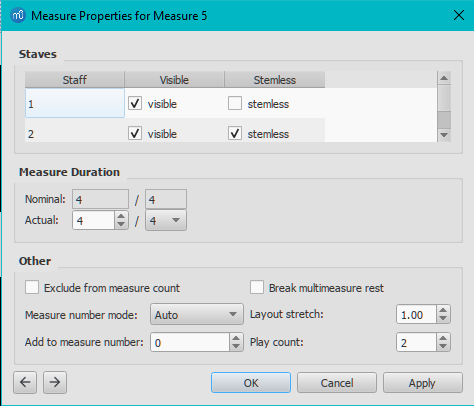
To open this window, right-click an empty part of the measure and select Measure Properties.... Modification are not applied until the user presses the Apply button. Use the left and right arrow buttons at the bottom left to navigate to a neighbouring measure.
Under Staves,
- Visible: Show staff lines.
- Stemless: Hide all note stems.
Under Measure duration,
- Nominal The Time signatures displayed when appropiate.
- Actual The real timespan allowed to accomodate notes and rests.
Under Other,
- Exclude from measure count: Exclude from counting. Used in e.g. a pickup measure.
- Break multimeasure rests: Prevent a multimeasure rest at the start of the selected measure. Edit this property prior to turning on Format → Style → Score → Create multimeasure rests if needed.
- Measure number mode: Whether and how measure numbers are displayed. See also the Layout and format : Measure Numbers chapter.
- Auto: Follows the setting in Format → Style → Measure Numbers.
- Always Show: Forces display of number.
- Always Hide: Hides number.
- Layout stretch: Controls the amount of horizontal space between score elements (notes, rests, etc.): See Increase/Decrease Stretch ({ and }).
- Add to measure number": Enter a positive or negative number to change the number of the selected measure, and subsequent meaures. A value of "-1" has the same effect as marking a measure to be excluded from measure count.
- Play count: If a measure precedes an end repeat barline, this value controls the number of times that the entire repeat section plays back. See the Repeats and jumps chapter.
Creating a pickup measure or anacrusis
Adjust Nominal and Actual settings to create pickup measure (also known as anacrusis or upbeat), cadenza, ad lib section etc.
In the image below, the quarter note pickup measure has a nominal time signature of 4/4, but an actual time sig. of 1/4. The measures in the middle are in normal 4/4 time. The complementary measure at the end of the staff, with a dotted half note, has an actual time sig. of 3/4.

A small - or + sign above the measure indicates its duration is different than indicated by the time signature (see image below). They can be turned off with View menu &arr; Mark Irregular Measures. The markers do not appear in printed copies.

Vertical alignment
See Barlines:Vertical alignment
Numbering
See the Layout and format : Measure Numbers chapter.
Split and join
Functions under Tools → Measure are disabled if the score contains Musescore Parts.
Split measures and join measures commands change Actual properties to adjust measure duration. They do not affect Time signature on the score, but beam grouping setting may be reset.
Join measures
- Select measure(s) on the score;
- Select Tools → Measure → Join Selected Measures.
Alternatively, join two neighbouring measures by selecting the barline in between and either (1) press Ctrl+Del (Mac: Cmd+Del) ; or (2) press V to make the barline invisible in printed copies (the barline still takes space).
Split a measure
Choose one of the following methods:
- Select a note; then hold Ctrl and click a barline in a palette (double-click in versions prior to 3.4);
- Hold Ctrl and drag a barline (from a palette) to the note that starts the next measure; or
- Select a note and press Tools → Measure → Split Measure Before Selected Note/Rest.
See also
- Barlines
- Measure (Layout and formatting style)
- Layout and formatting
- Breaks and spacers
External links
- How to span a measure over multiple systems (MuseScore HowTo, 1.x)
- How to split a measure (MuseScore HowTo, 1.x)
- How to delete measures (MuseScore HowTo)
- How to get scores without time signature (and clef) (MuseScore HowTo)
Voices
Not to be confused with human vocal Musescore Instrument, four-part SATB open score creation, or MuseScore Parts feature.
Overview
Musescore Voices is the software feature that is also known as "layers" in other notation software. Each staff (a piano grand staff has two staffs) has exactly four Voices. It has nothing to do with pitch range. See also Glossary: Part chapter. Selected score items are highlighted with respect to their Voices: Voice 1 blue, Voice 2 green, Voice 3 orange and Voice 4 purple. Voice of single selected item is also displayed on the bottom left status bar. This article indicates
- MuseScore Voice with captial letter V: Voices 1, Voice 2, Voice 3, Voice 4, and
- four-part harmony with S (Soprano), A (Alto), T (Tenor), B (Bass).

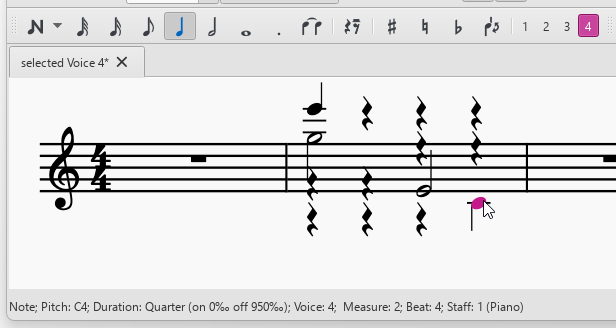
Reasons to use Voices
- To create concurrent rhythms on one staff. eg a chord composed of notes of varying duration, as shown above.
- To create chord with stems pointing in opposite directions, ie having Glossary: Shared note head.
- To create multiple mutable musical lines that use different sound samples for playback on one staff, as shown below. This feature is not implemented in MuseScore 4, but see its new Sound flags feature.
- To use automatic stem direction feature on polyphony. However, if the score is technically monophonic eg single line cantus firmus, it is preferable to only use Voice 1 and manually assign Inspector: Chord: Stem direction property or global setting.
- To create a SATB open score convertible to and from short score.
- To create a full score that can be extracted into individual scores using explode or MuseScore Parts: select voice function.
- To use plugins such as Check for parallel fifths and octaves.

Shown above Staff 1 Voice 1 instructed to use channel "Soprano", which is assigned Oboe sound; and Staff 1 Voice 2 instructed to use channel "Alto", which is muted. Score is O Come, O Come, Emmanuel. Translated John Mason Neale, arranged Thomas Helmore, transcribed Jojo-Schmitz.
Limitations of Voices
- Dynamics symbols cannot selectively affect Voice, but see update in Musescore 4.4.
- Cannot adjust individual Voice volume. Voices can be muted separately though.
Keyboard shortcut navigation
To select a note in a higher-numbered Voice than the current one:
- Use Alt + ↓, to move the selection to the bottommost note in the current Voice;
- Press Alt + ↓, to move to the higher-numbered Voice;
- Repeat any of the above steps, as necessary, until the desired note is selected.
To select a note in a lower-numbered Voice than the current one:
- Use Alt + ↑, to move the selection to the topmost note in the current Voice;
- Press Alt + ↑, to move to the lower-numbered Voice.
- Repeat any of the above steps, as necessary, until the desired note is selected.
Entering notes and rests
To notate a passage of music using Voice 1 and Voice 2,
-
Enter Voice 1 notes first: Make sure the app is in note input mode : the Voice 1 button becomes highlighted in blue in the toolbar.
 Always enter lower numbered Voice first, in this example Voice 1. On inputting, some notes may have down-stems, but these will flip automatically when the Voice 2 is added.
Always enter lower numbered Voice first, in this example Voice 1. On inputting, some notes may have down-stems, but these will flip automatically when the Voice 2 is added.The following excerpt shows a treble staff with just the Voice 1 notes entered:

-
Move cursor back to start of section: Upon finishing Voice 1 note entry, press the ← key repeatedly to move the cursor, note-by-note, back to the first note of the section; or alternatively use Ctrl+← (Mac:Cmd+←) to move the cursor back one measure at a time. Alternatively exit note input mode (press Esc) and click the first note.
-
Enter Voice 2 notes: Make sure the app is in note input mode and that the Voice 1 note at the beginning of the section is selected. Click on the "Voice 2" button
 (on the right of the toolbar), or use the shortcut Ctrl+Alt+2 (Mac: Cmd+Alt+2). Enter all the lower Voice notes (down-stem).
(on the right of the toolbar), or use the shortcut Ctrl+Alt+2 (Mac: Cmd+Alt+2). Enter all the lower Voice notes (down-stem).The following image shows the above example after the addition of Voice 2 notes:

Editing notes and rests
Automatic stem direction and override

- Notes in Voice 1 and Voice 3 have upward stem ; Voice 2 and Voice 4 have downward stem. This feature makes it easier to engrave polyphony.
- This feature will not activate in any measure where only Voice 1 is occupied but Voice 2, 3, 4 are missing. eg Beginner's error: for a Close/Closed score SATB, beginners often use Voice 1 for B (bass), this will not activate the automatic stem direction function, jump to tips.
- Assign overriding stem direction with Inspector: Chord: Stem direction.
Hiding or deleting rests
Rests are automatically added to unoccupied lower-number Voices. To avoid,
- Use lowest Voice number possible in each staff. eg Beginner's error: for a Close/Closed score SATB, beginners often use Voice 3 for T (tenor) or Voice 4 for B (bass), this will create unwanted rest symbols. jump to tips.
- Hide rest(s) on a score to make them invisible in printing.
See also the Remove selected range command which removes time segment.
Advanced users can also delete rests in Voices 2, 3 or 4 (but not Voice 1) by selecting them and pressing Delete. Deleting them may entangle future editing workflow as note entry overwrites at least one starting note/rest. The easiest way to restore deleted rests is to exchange that Voice with Voice 1 twice, which is commonly performed on file imported from XML or MIDI.
Exchanging Voices
To swap notes of two Voices,
- Select score items.
- Select Tools → Voices → [voice pair].
Works on measure - all notes and rests of measures within or touching the selected range (the blue rectangle).
Moving notes to another Voice (change notes' Voice but not swap)
To move without swapping,
- Ensure the app is in note input mode.
- Select note(s).
- Select a toolbar Voice button or press Ctrl+Alt+1–4 (Mac: Cmd+Alt+1-4).
Notes merge into chords if their note value match and they are not tied, content overwritten otherwise. See also plugin Merge Voices : 4 into 1 by yonah_ag which automates note value adjustment.
Merge four Voices
Merging notes of four Voices, where rhythm matches, into one is covered in the Tools: Implode chapter.
Separate chords into Voices
- Either:
- Manually select a continuous range of notes or a discontinuous list of notes, or
- Select notes using the Chord Level Selector plugin.
- Select a toolbar Voice button or press Ctrl+Alt+1–4 (Mac: Cmd+Alt+1-4).
To further separate into staffs, see Tools: Explode
Assigning sound
Sound in Musescore 3 is instrument channel based. Use Mid-staff sound (channel) change to assign a sound to a Voice.
Tips for writing SATB scores
- In Open score SATB (where four staves are used for the four voices separately), use Voice 1 in each staff.
- In Close/Closed score SATB (where two staves are used for the four voices, e.g., as in hymnals),
- use Voice 1 and Voice 2 only, for both upper and lower staves: in the upper staff use Voice 1 for S (soprano) and Voice 2 for A (alto) ; in the lower staff use Voice 1 for T (tenor) Voice 2 for B (bass)
- Beginner's error: use Voice 3 for T (tenor) or Voice 4 for B (bass), this will create unwanted rest symbols, jump to automatic rests.
- Beginner's error: use Voice 1 for B (bass), this will not activate the automatic stem direction function.
- There is usually no need to use Voice 3 and Voice 4
See also
- Keyboard shortcuts: Voices
- Tools (Implode, Explode)
- Glossary: Shared note head
- Noteheads: Shared noteheads
External links
- How to merge/combine/implode two staves in one with two voices (MuseScore HowTo)
- How to input multiple notes on a staff with different durations (MuseScore HowTo)
Selecting elements
Not to be confused with the note input cursor (caret) explained in Note input chapter.
Selected score items are highlighted with repect to their Voice, otherwise black or grey (if invisible) by default. The current selection status is shown on the bottom left status bar. There are four in total,
- "nothing is selected" status. The status bar is blank;
- "single item selection" status. The status bar shows the its type;
- List Selection status when multiple objects are selected;
- Range Selection status when a time segment across a given set of staves is selected. A blue rectangle is visible. Requirement of common operations such as Copy and Paste and repeat selection.
Shown below are single Voice 1 note selection (top); and "Range Selection" and status bar (bottom).
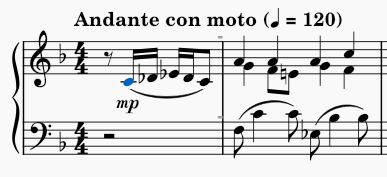
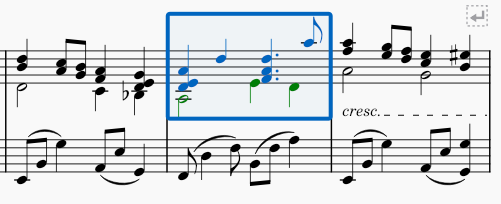
De-selecting
- Press Esc to reset to Normal mode.
- Press Esc again, or click empty page margin to deselect.
Clicking score item
- In Normal mode, click to select single score item except chord and measure. This repositions playback cursor.
- In Note edit mode, doing so repositions note input cursor.
Clicking chord notes
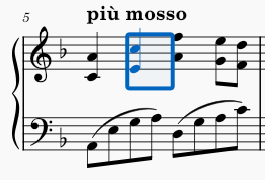
- Click notehead to select a note.
- Shift+click either one notehead to create a Range selection that encompasses the chord as shown above. The phrase "select a chord" refers to this command.
- Ctrl (Mac: Cmd) + click chord notes one by one to create a List Selection of multiple notes. Less commonly used.
Clicking a measure
- Click any blank space within measure to create a Range selection that encompasses it. The phrase "select measure(s)" refers to this command.
Selecting a single element
- Mouse click works as explained.
- Click notehead to select a note.
- Stem, flag, dot, accidental are selectable separately.
- In Normal mode, Left and Right navigate through notes (one note per chord) and rests.
- In Normal mode, Alt+Left and Alt+Right navigate through notes (every note of chord), rests, articulation, dynamics etc. See also the Viewing and navigation chapter.
- The phrases "select a chord" and "select a measure" refer to Range selection.
Selecting one in a group of overlapping items
- Ctrl+click to switch-select when items fully overlap each other eg notes in different Voices sharing the same pitch.
- In Normal mode, Alt+Left, Right navigate through every note of chord.
Selecting a note to copy its pitch only
- To copy every aspects of a note including duration, create a Range Selection containing it.
- To copy note pitch information only, which can be pasted onto note or rest, select the notehead. Removed in Musescore 4.
Creating a List Selection
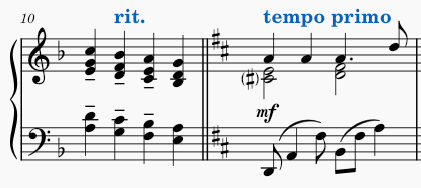
To select multiple score items other than notes or rests, Shift+click any blank space outside of staff lines and drag to create a selection box enclosing them.
To add or remove from the current selection, Ctrl (Mac: Cmd) + click (requires Musescore 3.5 version or later). This converts the selection to a List Selection.
To select a certain type of elements across the staff or the score,
- Right-click a score item.
- Select → All Similar Elements or All Similar Elements in Same Staff
To select by type within a virtual Range selection enclosed by those two item (requires Musescore 3.5 version or later),
- Select the first and top item.
- Shift+click the last and bottom element, or vice versa.
To select by type across a Range selection (works on all Musescore 3 versions),
- Create a Range selection
- Right-click an item inside
- Click Select→All Similar Elements in Range Selection
To create a more complex selection,
- Either,
- Create a Range selection, and right-click an item inside, or
- Right-click a score item,
- Click Select→More.
- Check required options (option availability varies with the right-clicked item),
Options available when the right-clicked item is a note are,
- Same notehead: see the Noteheads chapter.
- Same pitch: notes with the same pitch name, accidental, and octave.
- Same string: notes with the on the same string (tablature only).
- Same type: notes of the same type (normal, acciaccatura, appoggiatura).
- Same note type: notes of the same duration, not considering presence of dots or tuplets.
- Same duration: notes of the same actual duration.
- Same note name: notes with the same pitch name and accidental, not considering octave.
- Same staff: notes in the same staff.
- Same voice: see the Voice chapter.
- Same beat: based on time signature only, not beaming.
- In selection: from currently selected. Useful when the current is List Selection or Range selection.
- Same system: notes in the same system (layout concept. See Layout and formatting).
- Same measure: notes in the same measure.
Choose one out of four if required,
- Replace selection: deselect current selection.
- Add to selection: add to current selection. Converts to List Selection.
- Search in selection: filter currently selected items.
- Subtract from selection: removes from current selection.
Creating a Range Selection
To select notes and rests, Shift+click any blank space outside of staff lines and drag to create a selection box enclosing them.
To create a Range Selection enclosing a starting and an end note or rest,
- Select a note or rest.
- Optionally reposition the score.
- Shift+click another note or rest.
To create and resize a Range Selection,
- Select a note or rest.
- Hold Shift and resize
- by one chord with Shift+Left and Shift+Right,
- by one measure with Shift+Ctrl+Left and Shift+Ctrl+Right (Mac: use Cmd instead of Ctrl),
- by one staff with Shift+Up and Shift+Down,
- to the closest system (layout concept. See Layout and formatting) with Shift+Home and Shift+End, and
- to the beginning or the end of the score with Shift+Ctrl+Home and Shift+Ctrl+End (Mac: use Cmd instead of Ctrl)
- Release Shift.
For example, to select a chord (Range selection),
- Esc to reset to Normal mode.
- Left, Right to navigate to any chord note.
- Shift+Right
- Shift+Left
Special Range Selection commands
- Edit→Select all or Ctrl+A (Mac: Cmd+A) to select the entire score.
- Edit→Select section to select everything between two section breaks enclosing the current selection.
Excluding elements from a Range Selection
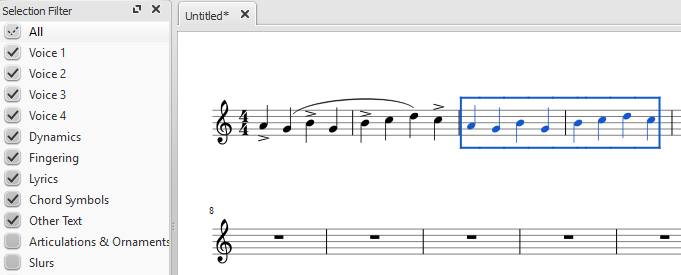
To remove items from (the current and any future) Range selection, uncheck options under Selection Filter window. For example, use this to leave out lyrics when duplicating notes and rests.
- View→Selection filter or F6 (Mac: Fn+F6).
- Uncheck options. eg. To copy content of measures 1 and 2 to 3 and 4 as shown in Example 1 above, uncheck Articulations & Ornaments and Slurs options.
- Create a Range selection.
- Execute command eg. Copy (Ctrl+C).
- Re-check options to restore selectability. See example 2.
- Select destination score item.
- Execute command eg. Paste (Ctrl+V).
Example 2: To copy Voice 2 items onto Voice 1,
- Uncheck Voice 1 option.
- Create a Range selection.
- Copy (Ctrl+C).
- Re-check Voice 1 option.
- Select destination Voice 1 item.
- Paste (Ctrl+V).
Undo and redo
MuseScore remembers an unlimited number of undo/redo actions.
The standard shortcuts are:
| Action | Windows & Linux | Mac |
|---|---|---|
| Undo | Ctrl+Z | Cmd+Z |
| Redo | Ctrl+Shift+Z or Ctrl+Y | Cmd+Shift+Z |
Or use the toolbar buttons: 
Viewing and navigation
This chapter describes the options available in the View Menu, and in the Zoom and Page View/Continuous View menus (located in the toolbar above the score). It also details the various navigation commands and functions.
View menu
Show sidebars/panels
- Palettes: F9
- Master palette: Shift+F9 (Mac: Fn+Shift+F9)
- Inspector: F8 (Mac: Fn+F8)
- Play Panel: F11 (Mac: Fn+F11)
- Navigator
- Timeline: F12
- Mixer: F10 (Mac: Fn+F10)
- Synthesizer
- Selection filter: F6 (Mac: Fn+F6)
- Piano keyboard: P
- Score comparison tool
Zoom in/out
There are several ways to zoom the score in or out:
-
Keyboard shortcut:
- Zoom In: Ctrl++ (Mac: Cmd ++)
- Zoom Out: Ctrl +- (Mac: Cmd +-).
-
View menu:
- Zoom In: View→Zoom In
- Zoom Out: View→Zoom Out.
-
Mouse
- Zoom In: Scroll up with the mouse wheel while holding down Ctrl (Mac: Cmd)
- Zoom Out: Scroll down with the mouse wheel while holding down Ctrl (Mac: Cmd).
-
Drop-down menu: To set a specific zoom, use the dropdown menu in the standard toolbar to set the view magnification of the score (25–1600 %) or display it using the options "Page Width", "Whole Page", or "Two Pages".

You may type a custom zoom % into the dropdown field if your desired zoom level isn't available by default. -
To return to 100% zoom: Use the shortcut Ctrl+0 (Mac: Cmd+0).
Toolbars
The Toolbar area is located between the Menu bar and the document window.

It contains the following toolbars:
- File Operations: New score, Load score, Save, Print, Undo, Redo.
- Zoom/Page View.
- Playback controls: Enable MIDI, Rewind, Play/Stop, Loop, Play Repeats, Metronome.
- Concert Pitch: Displays score in written or concert (sounding) pitch.
- Image Capture: Allows you to take a snapshot of part of the score.
- Note Input: Note entry mode, Duration, Tie, Rest, Accidentals, Flip stem direction, Voice (1, 2, 3, 4).
Show/hide toolbars
To show or hide certain toolbars:
- Select View→Toolbars, and tick/untick the options as required.
- Alternatively, right-click on an empty space in the toolbar area, or the title bar of the Inspector, and, from the menu, check or uncheck the required options.
Note: This option also allows you to show or hide the Timeline, Score Comparison Tool, Script Recorder, Piano Keyboard, Selection Filter, and Drumset Tools.
Customize toolbar area
-
Select View→Toolbars, and click on "Customize Toolbars…"
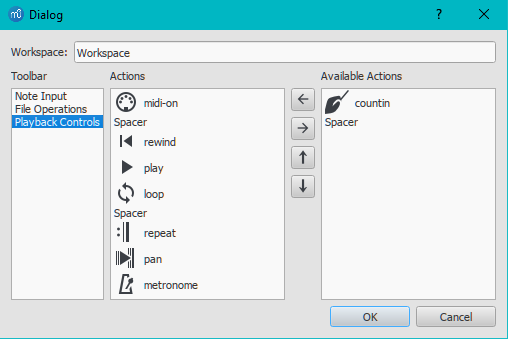
The dialog shows the toolbars that can be customized on the left, the current tool buttons for the selected toolbar in the middle, and the buttons that can be added on the right. When you have selected a toolbar in the left panel, you can do any of the following actions:
- Remove a toolbutton: Select the button in the middle panel, and press →.
- Add a toolbutton: Select the button in the right panel, and press ←.
- Move a toolbutton: Select the button in the middle panel, and move it up or down using ↑ or ↓.
Note: The toolbar cannot be customized unless a custom workspace is selected (see below).
Workspaces
Select this option to create a custom workspace or to edit an existing workspace.
Show Status bar
The Status bar, at the bottom of the screen, gives information about selected score elements. Tick/untick this option to display or hide.
Split display
It is possible to split the document display so as to view two documents at once, or to view two different parts of the same document. Tabs allow you to choose which document to display in each view. You can drag the barrier separating the two scores to adjust the amount of space in the window devoted to each:
- Documents Side by Side: Divides the window vertically into two score views.
- Documents Stacked: Divides the window horizontally into two score views, one above the other.
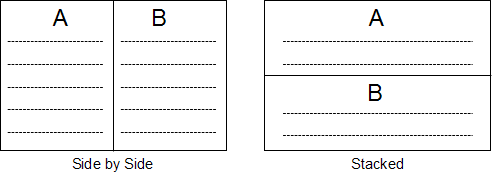
Visibility options
This section allows you to display or hide various non-printing elements:
- Show Invisible: View/hide elements that have been made invisible for printing and export. If this option is ticked, invisible elements are shown in the score window as light gray.
- Show Unprintable: View/hide breaks and spacer symbols.
- Show Frames: View/hide the dotted outlines of frames.
- Show Page Margins: View/hide Page Margins.
Mark irregular measures
A plus sign or minus sign at the top right of a measure indicates that its duration differs from that set by the time signature.
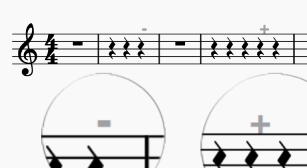
Full screen
Full Screen mode expands MuseScore to fill your screen so more content is visible.
Page/Continuous View
You can switch between different views of the score using the drop-down list in the toolbar area:
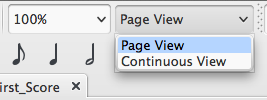
To scroll the score:
- Vertically: Move the mouse wheel up or down.
- Horizontally: Press Shift and move the mouse wheel up or down.
Page View
In Page View, the score is formatted as it will appear when printed or exported as a PDF or image file: that is, page by page, with margins. MuseScore applies system (line) and page breaks automatically, according to the settings made in Page settings and Style…. In addition, you can apply your own system (line), page or section breaks.
To choose between horizontal or vertical page scrolling, see Preferences: Canvas (Scroll pages).
Continuous View
In Continuous View, the score is shown as one unbroken system. Even if the starting point is not in view, measure numbers, instrument names, clefs, time and key signatures will always be displayed on the left of the window.
Note: Because the layout is simpler, MuseScore may perform faster in Continuous View than Page View.
Single Page View
In Single Page View the score is shown as a single page with a header but no margins, and with an infinite page height. System (line) breaks are added automatically, according to the settings made in Page settings and Style…. In addition, you can apply your own system (line) or section breaks.
Side panels
The workspaces, Inspector and Selection filter are conveniently displayed as side panels to the left and right of the score window. To undock a side panel use one of the following methods:
- Drag the panel;
- Click on the double chevron at the top of the panel;
- Double-click in the title area at the top of the panel.
To dock a panel use one of the following procedures:
- Drag the panel to the top/bottom of an existing side panel and it will stack vertically above/below that panel.
- Drag the panel to the middle of an existing side panel and it will overlay that panel. Both panels can then be accessed by tabs.
Alternatively, double-clicking the title bar of the panel will restore it to its previously docked position.
Navigation
Commands
Various commands are available to help you navigate more easily through the score. These are listed under Keyboard shortcuts: Navigation.
Navigator
The Navigator is an optional panel which displays page thumbnails of the score at the bottom or to the right of the document window.
- To view or hide the Navigator, select View→Navigator; or use a customized shortcut.

The Navigator appears at the bottom of the document window if scrolling pages horizontally; or on the right if scrolling pages vertically (see Preferences: Canvas).
The blue box represents the area of the score that is currently visible in the document window: drag the box, or click directly on the navigator panel to bring another part of the score into view. You can also drag the scrollbar.
Timeline
The Timeline panel provides a detailed overview of the score, with expanded possibilities for navigation and interaction.
- To display the Timeline, press F12; or select View→Timeline.
For details, see Timeline.
Find / Go to
The Find / Go to function allows you to speedily navigate to a specific measure, rehearsal mark or page number in the score:
- Press Ctrl+F (Mac: Cmd+F), or select Edit→Find. This opens the Find (or Go to) bar at the bottom of the workspace.
-
Use one of the following options:
- To go to a numbered measure: enter the measure number (counting every measure, starting with 1, irrespective of pickup measures, section breaks or manual changes to measure number offsets).
- To go to a numbered page: enter the page number using the format pXX (where XX is the page number).
- To go to a numerical rehearsal mark: enter the number using the format rXX (where XX is the name of the rehearsal mark).
- To go to a rehearsal mark starting with a letter: enter the name of the rehearsal mark (the search is case insensitive).
N.B.: It is best to avoid naming rehearsal marks with the single letters "R", "r", "P", "p", or one of these letters with an integer (e.g. "R1" or "p3"), as this can confuse the search algorithm.
Note: The "Pan score automatically" toolbar button must be enabled for the Find command to be able to reposition the score view to the correct location.
See also
Concert pitch
You can choose to display the score in either written or concert (sounding) pitch. Written pitch displays the score as it should look when printed for musicians to read. However, during preparation you may prefer the convenience of seeing the transposing instruments notated as they sound, without transposition. In this case you should select the "Concert pitch" option.
To toggle the score display between written or concert pitch:
- Press the Concert Pitch button (located in the top right of the toolbar area). When this button is highlighted the score is in concert pitch.
Before printing the score, exporting it to PDF or saving it online, you should ensure that the Concert Pitch button is off, and that the individual parts are correctly transposed.
See also
External links
- Concert pitch (Wikipedia article)
- Transposing Instrument (Wikipedia article)
- Concert pitch or not? (MuseScore forum discussion)
Copy and paste
The cut, copy, and paste commands can be used to reproduce entire passages of music, to move music earlier or later, to copy text or other markings between staves, to exchange the content in different measures, and more.
Accessing the commands
In all cases, the first step is to create a selection of element(s), see Selecting elements chapter.
As with other programs that support cut, copy, and paste, you can access these commands from the Edit menu, from a context menu that appears upon right-click or related gesture (e.g., Ctrl+click, or two-finger tap), or via the standard keyboard shortcuts.
| Command | Shortcut (Windows) | Shortcut (Mac) | Context menu | Main menu |
|---|---|---|---|---|
| Cut | Ctrl+X | Cmd+X | Cut | Edit→Cut |
| Copy | Ctrl+C | Cmd+C | Copy | Edit→Copy |
| Paste | Ctrl+V | Cmd+V | Paste | Edit→Paste |
| Swap with clipboard | Ctrl+Shift+X | Cmd+Shift+X | Swap with Clipboard | Edit→Swap with clipboard |
| Paste half duration | Ctrl+Shift+Q | Cmd+Shift+Q | N/A | Edit→Paste half duration |
| Paste double duration | Ctrl+Shift+W | Cmd+Shift+W | N/A | Edit→Paste double duration |
Note: (1) When using the context menu, take care to always right-click on a selected item; if you right-click on an empty space by mistake your selection will be lost! (2) Paste half/double duration requires Musescore 3.1 version or later.
Copying a Range Selection
As explained in the Selecting Elements chapter, in a Range selection, Musescore automatically selects useful elements between given beginning and ending time positions across a given set of staves. These elements includes all of the notes, rests, Musescore Texts such as dynamics symbols, Musescore Lines such as pedal etc. System-wide elements such as Tempo, Time signatures, Repeats, Layout breaks are not included in the automatic selection, thus are not copied.
Upon pasting onto a destination time position, the copied music replaces all of its existing content, except for its original measure rhythm structure and system-wide elements.
- Create a Range Selection.
- (Optional) Use the Selection Filter to exclude other elements of a given type.
- Use the Copy command from the menu or press Ctrl+C (Mac: Cmd+C)
- Select the first note or rest of the destination
- Use the Paste command from the menu or press Ctrl+V (Mac: Cmd+V)
Copying a single element or a List Selection
(Copying a List Selection requires Musescore 3.5 version or later)
MuseScore also allows copying a single element, or a List Selection of multiple lyrics, chord symbols, dynamics, articulation, or other markings from one place to another, while keeping the content such as notes in the destination intact.
If a single note selected by notehead, upon copying only the pitch is copyed into the destination note. To copy and paste everything, including duration etc, create a Range Selection of the note first, see Selecting Elements chapter. Pitch only feature is removed in Musescore 4.
Multiple notes List Selection cannot be copied.
MuseScore preserves the relative time positions of the markings based on literal note value distance if possible, measure rhythm is not taken into account. This includes case of copying chord symbols and dynamics. Valid note or rest anchors are required at the destination music when pasting lyrics and articulations.
- Select a single element (except Measure), or create a List Selection , see Selecting Elements chapter.
- Use the Copy command from the menu or press Ctrl+C (Mac: Cmd+C)
- Select the first note or rest of the destination
- Use the Paste command from the menu or press Ctrl+V (Mac: Cmd+V)
Moving elements
Cut and paste commands can be used to
- move a passage to another staff, such as music on flute to clarinet, or
- shift a passage earlier or later. This method is especially useful as a way to insert or delete a note or rest and also shifts existing notes and rests to create or trim silence.
Measures (their rhythmic structure) cannot be moved, but see Measure operations and Time signatures chapters. When moving List Selection, its elements' relative positions are preserved if possible, see "Copying a List Selection" section.
To move a selection:
- Select what you want to move
- Use the Cut command from the menu or press Ctrl+X (Mac: Cmd+X)
- Select the first note or rest of the destination
- Use the Paste command from the menu or press Ctrl+V (Mac: Cmd+V)
Swapping a selection with the clipboard
The swap with clipboard command combines two operations into one: (1) First it overwrites a selected part of the score with the contents of the clipboard, just like the paste command; (2) Second, it transfers the overwritten part of the score back to the clipboard, just like the copy command.
It can be used, for example, to swap two equal-length sections of a score, A and B:
- Select section A
- Apply the cut command
- Select section B
- Apply the swap with clipboard command to paste A over the contents of B while moving the contents of B to the clipboard
- Select section A again (or just the first note, rest, or measure)
- Apply the paste command
Like the other commands discussed here, you can access the swap with clipboard command from the menu or via a keyboard shortcut—in this case, it is Ctrl+Shift+X (Mac: Cmd+Shift+X).
Repeating a selection
A common use for copy and paste is to duplicate a given passage (including notes, chords etc) immediately after the original. Use the special repeat selection command to simplify this process.
- Select a single element on the score, or create a Range Selection, see Selecting Elements chapter.
- Press R
This does not work on List Selection. It works on a single chord, either on a Range Selection of it, and when exactly one note of that chord is selected. See Selecting Elements chapter. In note input mode, this command repeats the entire chord that contains the current note. This is useful for creating a series of repeated chords.
Copying a Range Selection to multiple staves
If you wish to copy a passage to multiple staves—for instance, to double music of flute with oboes and clarinets&mdash:
- Select the passage you wish to copy
- Extend the selection to include the staves below (e.g., by pressing Shift+↓)
- Use Tools→Explode
This copies the original selection, assuming it contains only single notes—no chords and no multiple voices. If there are chords or multiple voices, then these are distributed among the remaining staves. For more on Explode command, see Tools chapter.
Paste half/double duration
Requires Musescore 3.1 version or later.
If you have entered a passage using mostly eighth notes but wish to halve the entire passage to using mostly sixteenth notes, or double it to quarter notes, MuseScore provides a pair of special commands to accomplish this. You can either modify the durations of a selection in place or create a separate copy of the passage with the modified durations. To halve or double the duration of a passage:
- Create a Range Selection
- Use the copy command
- If you wish to create a separate copy of the passage with the modified durations, select the destination
- Use the paste half duration or paste double duration command Ctrl+Shift+Q/W ( Cmd+Shift+Q/W)
Duplicating individual elements
Individual elements—even those that are not selected automatically in a Range Selection, like time signatures or voltas—can be selected and then duplicated using a mouse.
- While pressing Ctrl+Shift (Mac: Cmd+Shift), and click and hold on an element
- Drag it anywhere in the score
- When you release the mouse button, the selected element is copied to the new location
See also
- To change notes without altering the rhythm, use Note input mode, select Re-pitch mode, then use copy and paste commands. See Note input modes chapter.
Open/Save/Export/Print
Native format compatibility
MuseScore native format (*.mscz and *.mscx) are backward compatible: MuseScore 4 opens MuseScore 3's *.mscz without error.
MuseScore native format has never been forward compatible, see forum discussion. Although partial data retrieval is still possible as of MuseScore 4.0.2, you should not rely on it for score data integrity. Some features present in MuseScore 3 have not (yet) been included in MuseScore 4, and internal data conversion occurs when you open a older version file with a newer version program and then overwrite the file using the save function.
Some users find it useful to keep all data intact by creating seperate folders to store score files designated for editing on different Musescore versions, it is recommended to duplicate files before opening them as required.
File menu
In the File menu you can find options for opening, saving, exporting and printing your file:
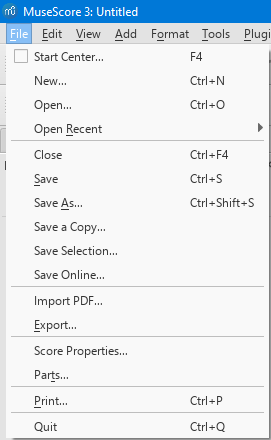
Open
Apart from native format files (*.mscz and *.mscx), MuseScore can also open MusicXML, compressed MusicXML and MIDI files, as well as a variety of files in other formats.
To open any supported file:
- Choose one of the following options:
- Press Ctrl+O.
- Click on the "Load score" icon on the left side of the toolbar area.
- From the menu bar, select File→Open....
- Select a file and click Open; or simply double-click a file.
Open recent allows you to choose from a list of recently-opened scores.
Save
Save, Save As…, Save a Copy… and Save Selection… allow you to save native MuseScore files (.mscz and .mscx).
- Save: Save current score to file.
- Save As...: Save current score to new file.
- Save a Copy...: Save current score to new file, but continue to edit original file.
- Save Selection...: Save selected measures to new file.
- Save Online...: To save and share your scores on the web at MuseScore.com. For details, see Share scores online.
Export
Export... allows you to create non-MuseScore files, such as PDF, MusicXML, MIDI, and various audio and image formats. In the Export dialog, you can choose which format to export to.
- Export...: Export current score to format of your choice.
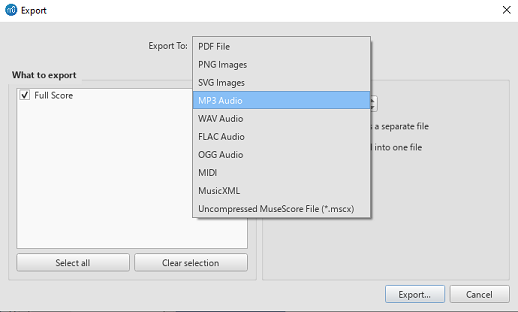
Here you can also select whether to export parts and which
MuseScore remembers which format you picked the last time and makes that the default for the next time.
Print... allows to print your MuseScore file directly to a printer from MuseScore. Depending on your printer you will have different options, but generally you can define the page range, number of copies and collation.
If you have a PDF printer installed, you could also "export" to PDF using Print, but it's usually better to use the native PDF option under Export for more accurate rendition. Note: For this to work properly with Adobe PDF, make sure to uncheck "Rely on system fonts only, do not use document fonts" in Printer properties.
See also
Share scores online
Musescore.com allows you to:
- View and listen to scores from a large repository created by the MuseScore community.
- Download any score in a variety of formats—MuseScore, MusicXML, PDF, MIDI, MP3.
- Upload your own scores: control whether to share them publicly or privately (via a secret link).
- Synchronize your score with a YouTube video ("Videoscores").
Note: A MuseScore Pro account is required for all scores not marked as PD (Public Domain) or "Original" work, the latter must also have the approval of the score owner.
Create an account
- Visit MuseScore.com and click on "Create new account". Pick a username and enter a valid email and press "Create New Account".
- Wait a few minutes for an email from MuseScore.com support. If no email arrives, check your spam folder.
- Click the link in the email and visit your user profile to change your password.
Share a score directly from MuseScore
To save a score online:
- Make sure that the Concert Pitch button is off, and that the individual parts are correctly transposed.
-
From the menu, select File→Save Online.... The "Log in to MuseScore" dialog will appear:
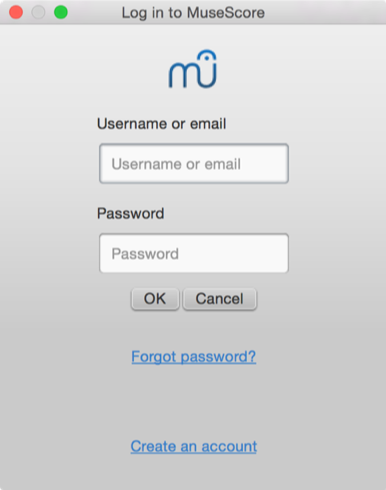
-
Enter your email address or MuseScore username, and password, then click OK. Note: If you don't have a MuseScore account yet, create one first by clicking on the "Create an account" link. That will open your browser app and bring you to musescore.com/user/register.
-
Upon successfully logging in and if the score already exists online, it will be updated automatically. Uncheck Update the existing score to save online as a new score.

-
If you are using a different SoundFont than the default one and if you are able to export MP3 files (may not be the case on some Linux versions), a checkbox Upload score audio will be visible:

If the checkbox is checked, MuseScore will render the audio of the score using the current synthesizer settings and upload the audio to MuseScore.com. -
Now you'll be able to enter your score information.
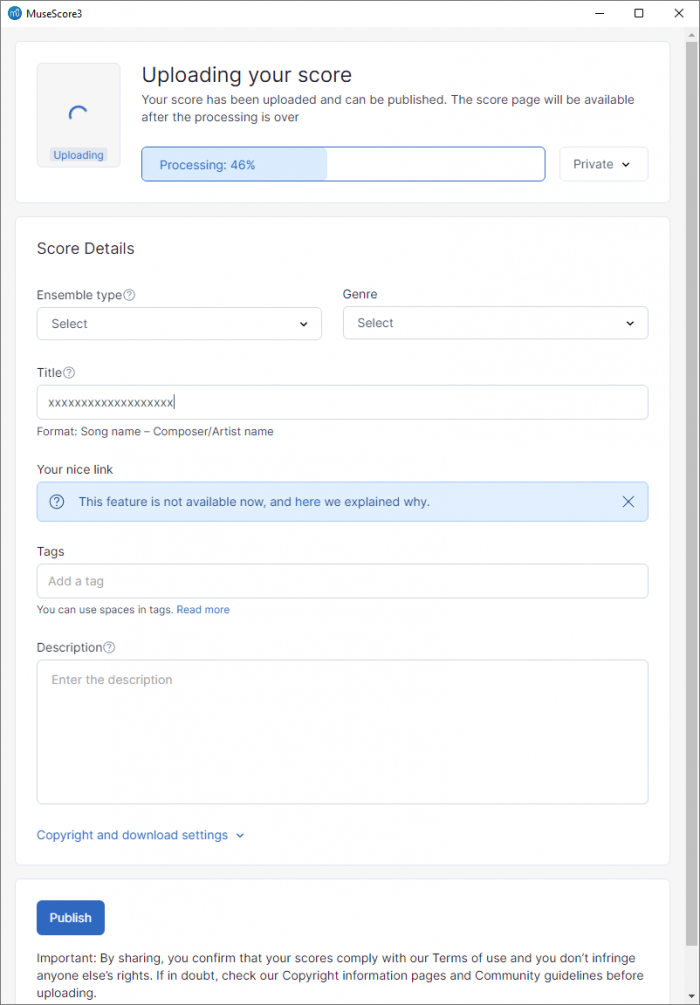
- Make the score private: If selected, the score can only be viewed via a private link. If set to public, the score is visible to all.
- Ensemble type: A list of possible values
- Genre: A list of possible values
- Title: The title of the score.
- Description: The descriptive text that will appear next to it.
- Copyright and download settings: Choose an appropriate copyright license from the drop-down list.
Note: Creative Commons license, allows people to use your scores under certain restrictions.
Here you also can restrict the ability of others to download your score (requires a Pro membership on MuseScore.com).
Upload a score on MuseScore.com
You can also upload a score on MuseScore.com directly:
- Click the Upload link on MuseScore.com.
- You have the same options as with the Save Online menu, except for uploading score audio.
Edit a score on MuseScore.com
If you want to make changes to one of your scores on MuseScore.com, edit the MuseScore file on your own computer, save it, and then do the following:
- If you originally shared the score directly from within MuseScore, simply go to File→Save Online... again to update the online score.
- If you originally uploaded the score via the Upload page on MuseScore.com, then you must follow these steps to update the online score:
- Go to the score page on MuseScore.com.
- Click the three dots menu ⋮ on the right and choose "Update this score".
- In the form, you can upload a replacement score file as well as change the accompanying information and privacy settings.
Switch to the direct method of updating an online score
It is much more convenient to update online scores from directly within MuseScore than by updating the score manually from the score page. Follow these steps if you originally uploaded the score via the Upload page and now want to switch to the direct method:
- Go to the score page on MuseScore.com and copy the URL.
- Open the score file on your computer with MuseScore.
- From the menu, select File→Score Properties... and paste the URL into the "Source" field.
Now whenever you want to update the online score simply go to File→Save Online....
Note: The URL should be follow the format of https://musescore.com/XXXXXXXX/scores/XXXXXXXX and should not contain 'Nice Link's.